Progress report for FNC23-1386
Project Information
Trisha Nieder: Trisha grew up on her family’s Black Angus cattle farm. After 20 years in cities - New Orleans, New York, Miami - Trisha and her husband realized the value of the farm’s preservation. They moved back and are transitioning the farm to sustainable practices to build a profitable business. Trisha studied sociology and English in New Orleans. Accepted into the highly competitive New York City Teaching Fellows Program, she taught high school from 2007-2009. She was the Grant Manager for a $100K federal MLK Day of Service grant and a grant writer for Best Buddies international and was responsible for writing and reporting on grant funds. She’s currently a Vice President at Max Borges Agency, where she built their branding and creative department. She has a strong background in marketing, visual design, and public relations. She manages accounts, leads brand strategies, and manages teams of 10+. The agency, based in Miami, is remote, allowing Trisha the freedom to work from home at the farm while also growing a national network of coworkers, clients, and marketing partners.
Daniel Gonzalez: From Miami, Daniel is a first-generation Cuban American. During college Daniel met Trisha. Over the years he fell in love with the farm and aims to expand and diversify the farm with poultry, native Missouri horticulture, and regenerative approaches. He attended Loyola University for marketing, and worked for a decade in experiential event marketing. He later worked in beverage sales, and is familiar with infrastructure and set up for grocery stores, restaurants, and bars. Current Role: Daniel is focused on working on and growing the farm business as a full time role. Since moving in September, he’s already expanded our local network through Mizzou’s Agricultural Food and Natural Resources extension, the University of Missouri Soil Testing Lab, the Missouri Department of Conservation, Forrest Keeling Nursery, the local 4H chapter and MFA, and several more. Daniel and Michael will be responsible for day to day labor and farm maintenance.
Michael Nieder: For 40+ years, Mike has stayed up to date on the latest farming practices and organizations; bred, raised, grew, and maintained what is now 65+ herd of purebred Black Angus cattle; and ensured that Nieder Farms continued through a fourth - and now fifth - generation. Mike’s decades of knowledge and first-hand experience is what has kept Nieder Farms running, and now he’s applying it to the farm’s future growth.
- Losing formerly vibrant towns and farming communities in Franklin County:
-
-
- Franklin county farmers are aging with few replacements. Farms are rapidly being sold for development properties. In November 2022 alone, nearly 2,200 acres were for sale (accounting for 10+ acre properties). A once vibrant farming community is quickly declining.
- Younger people don’t see the value in farming and preserving farmland.
- Fewer local farms means less local food for sale, and fewer dollars being reinvested into the community.
-
- Cow/calf farms are not economically sustainable.
-
-
- Rising prices across diesel, corn, and hay make tight profit margins tighter. With repairs and replacements on farm equipment, there’s little funds to invest in growth.
- Due to a higher volume of cattle from larger, big-name farms at local auctions, live cattle is no longer a viable revenue source for small farmers.
- Labor intensive operations such as cutting, raking, and baling hay leaves little time to invest in farm growth. Farmers work full-time jobs to pay the bills and keep the farm.
-
- Cow/calf farms are not environmentally sustainable:
-
- Continuous/overgrazing is stripping soil of key nutrients. Grass is neither nutrient rich, nor diverse. Soil erosion and loss of topsoil is inevitable.
***VIEW SUSTAINABILITY GUIDE***
- Build and strengthen relationships in local farmer community.
-
- Partner with local 4H to host five experiential education workshops to inspire new generations of farmers. Invite groups to the farm to teach sustainable (economic and environmental) farm practices first-hand. Currently our 4 H group has business relationships, but no hands-on partnerships with local farms. The Franklin County 4 H group is the largest in Missouri.
- Develop a unique print and digital startup guide based on findings and geared to local Missouri cattle farmers. Featuring original illustrations by Trisha it will visually - and very simply - walk farmers through clear steps on how to start/transition to a sustainable cow/calf farm and improve profitability. Resources (experts, organizations) will be included as well.
- Support local farmers by becoming an education resource. Partner with local organizations (i.e. Cattleman’s Association, FFA, local farm bureaus and agencies) and others to distribute 300 printed sustainable startup guides. Provide the guide free online at NiederFarms.com, and promote it via digital advertising to Missouri cow/calf farmers, exposing local farmers to sustainable practices and giving them the tools to get started.
- Use Nieder Farms to teach local farmers - emphasis on cow/calf farmers - how to increase profitability.
-
- Nieder Farms - a fifth generation cattle farm - faces similar economic sustainability issues as other local farms. We will increase profitability among the local farmer community by demonstrating how two changes on cow/calf farms can increase profit margins. We will provide insights, steps, and support so others can do the same.
- Nieder Farms will transition to management intensive grazing to increase herd grazing days and save on diesel, hay, and corn costs and cut labor hours. This will result in better profit margins, less labor, and more time for farmers to invest in growth opportunities.
- Introduce new enterprises to the cow/calf farm to diversify income streams and stabilize profits. Diversify revenue streams in two ways: introduce poultry (chickens and turkeys) for meat, and plant a fruit orchard for eventual sales.
- Use Nieder Farms to demonstrate the value of sustainable farming practices, and the positive impact they have on the environment and farming.
-
- Improve the environment by transitioning Nieder Farms from continuous grazing to management intensive grazing to restore organic topsoil. By effectively using grazing practices, we can fertilize, control grass growth cycles, manage weeds without chemicals, and - in year two - introduce native grass varieties and clover to diversify grasses, support soil health, and increase nutrients for cattle.
- Plant native fruit trees such as pawpaw, cherry, apple, elderberry to help with soil erosion, and begin building a strong foundation for a diverse farm ecosystem.
- Introduce pasture raised poultry that play a role in improving the environment through fertilization and pest control. Poultry will be moved via a chicken tractor to fresh grass daily, ensuring ongoing soil support, lower feed costs, and higher quality meat.
- Educate the broader community why environmental practices not only produce healthier, nutrient rich beef and poultry but also benefits their local environment.
Objectives
- Strengthen relationships among young farming community:
-
-
- Partner with local FFA and 4H for a sustainable farming workshop and experiential education.
- Create and distribute a startup guide for sustainable farming in Franklin County and Missouri.
- Become a resource.
-
- Diversify production and revenue streams:
-
-
- Reduce costs tied to baling and buying hay by 50%.
- Reduce labor tied to baling hay by 50%.
- Raise and process 200 chickens and 50 turkeys.
-
- Improve soil quality:
-
- Implement management intensive grazing.
- Plant two varieties of native grasses or clover.
- Plant at least three varieties of native fruit trees.
- Utilize poultry to continuously fertilize and control pests.
Cooperators
- - Producer
- - Producer
Research
- Overall, the more planning and organization you put in early on, the less overwhelming and better your results will be over time. The first thing we did to get organized was list our objectives, equipment, and action items, and then organized them by month. This made it much easier to manage the project in smaller pieces, rather than get overwhelmed. Some examples: we started by purchasing the various equipment we'd need (scalder, plucker, materials for chicken tractors, freezer, coolers, tools, etc.) so we could set up the infrastructure.
- In the early months, we also planned our poultry timing - counting back from when we wanted the batches of chickens to be ready to the month we needed to have them arrive.
- We did a lot of outreach to local resources (e.g. NCRS, extension office, State of Missouri Department of Agriculture Division of Animal Health, etc.) early in the year (e.g. Jan.-Mar.) to get our poultry exemption, learn the best way to arrange our paddocks, learn how to measure forage and types of forage, and more. This is also when we reached out to the 4H leaders to schedule workshops throughout the year.
- In early spring, we got to work on some of the more manual labor and prep work, like building the chicken tractors and setting up brooders so we were prepared for the chickens.
- We kept detailed records throughout the year. This included checking off the list mentioned above (and adding things as needed), as well as keeping track of our expenses, timelines, and customer information (e.g. emails). This record keeping of expenses and timelines - especially tied to raising and processing chickens - was incredibly helpful. In 2024 we can now better estimate the amount (and expense) of feed, the time needed to raise chickens to a profitable weight, and get the best pricing for the chicks for better profitability margins. The same is true for rotational grazing timelines
- Sharing progress and content on social media is very important to growth. We try to post photos or videos at least once a week, if not more. Since we run social advertising to purchase steers (freezer beef), it goes a long way in credibility and trust for a consumer to click the ad and then see a variety of content as proof of our farm's legitimacy and practices. Along with this, having frequently asked questions available on our website helped dramatically in saving our time needed to explain pricing and processes, and offered even more confidence and clarity to consumers.
- Similarly, maintaining customer information (emails) is useful. You can leverage one type of customer (beef) for another (poultry) and grow profits this way. We leveraged our beef customer base for our first batch of chickens, and sold out entirely, never needing to advertise on social to new customers.
- For rotational grazing and setting up paddocks, the most important thing is to get started. Set up your first paddock, see how quickly the herd goes through the forage, and begin gauging when to move them to the next paddock. Knowing the basics is helpful to estimate the number of cattle and acreage, however learning by doing is incredibly effective. Seeing first hand how much your herd consumes and getting a feel for how often to move and manage them is helpful.
- Connecting with like-minded people and other farmers is important to success. Reach out to local extension offices, groups (e.g. 4H, FFA, Cattleman's Association, MFA, etc.) to find helpful resources. Reach out to other local farmers via their social media accounts. Making connections and getting advice and guidance outside of books or videos is priceless, especially when it's hyper-local.
Below are the 2024 additions to our materials and methods:
- Expanded Infrastructure
- We built two more chicken tractors, and borrowed one additional tractor - for a total of four this season - and acquired an additional freezer to accommodate increased production. We also added more portable electric reels and posts to improve rotational grazing efficiency, particularly using smaller paddocks.
- Record-Keeping
- Soil health testing was conducted to measure improvements from rotational grazing. We also kept track of the amount of hay baled and labor needed throughout the winter to feed our herd. This information, combined with our profitability data from 2023 and 2024, allowed us to identify specific cost-saving measures, such as reducing feed costs and optimizing forage usage.
- For our chickens, we continued to keep close cost/profit records for our chicken sales as well, finding ways to reduce input costs by one dollar per bird, while also increasing each bird’s overall weight for better profitability.
- Although our steers (freezer beef) were not a formal part of this project, it is also worth noting that our new grazing practices have positively impacted decisions and actions regarding the management of that herd as well. In 2025, we will be minimizing our use of our feedlot, and instead keeping the steers on the pasture longer, reducing ongoing feed costs even further, and taking a step to reduce erosion in the feedlot area.
- Newly Planted Orchard
- While our newly planted orchard is still in its early stages, we observed that native fruit and nut species are more resilient and require fewer inputs compared to non-native varieties. This insight has already guided planting decisions for 2025, to help avoid the challenges of managing non-native trees and determine which perform well on our farm.
- Workshops and Community Engagement
- In 2024, we hosted two 4-H workshops focused on orchard planting and chicken processing. These events provided hands-on education and a unique opportunity to connect with the community.
- While the workshops primarily focused on teaching, they revealed that even within our local farming community, sustainable and regenerative practices are not widely known but are highly intriguing. Parents often attended alongside their children, taking notes and asking questions. Many later connected with us through social media, referred friends, or became customers of our chickens and beef.
- Refinements to Rotational Grazing
- We face limitations with our rotational grazing due to water access, however, in our second year we got more aggressive with our paddock sizes and grazing intervals. These adjustments extended the grazing season into early winter, even during challenging weather conditions (heavy rain, snow).
- Enhanced Marketing and Outreach:
- Social Media Campaigns: Highlighted our grazing, poultry, and orchard systems, while sharing soil health improvements and cost-saving metrics. These updates built consumer confidence and resonated with our audience.
- Other Sustainable-Focused Content: Posted about permaculture and pest control practices (e.g., using guinea fowl) on social media, attracting customers interested in our holistic, chemical-free farming approach.
- Business Card Distribution: Placed in gyms, coffee shops, libraries, and local stores, generating inquiries and expanding word-of-mouth referrals.
- Leveraging Eggs to Introduce Meat: Sold eggs from our personal laying hens locally, including business cards with each carton. This simple strategy introduced customers to our farm and increased chicken and beef sales.
- Highway Visibility: Positioned chicken tractors along the highway, leading to organic promotion through local Facebook groups. This visibility strengthened the community’s association of our farm with sustainable practices and quality food, leading to even more word of mouth inquiries and orders.
Strengthen relationships among young farming community
- Partner with local FFA and 4H for a sustainable farming workshop and experiential education.
- Collaborating with local FFA and 4 H groups was a key goal of this project, fostering education and interest in sustainable farming practices among youth and community members.
- Workshops and Participation
- Hosted four 4 H workshops from 2023 to 2024, providing hands-on learning opportunities for 43 individuals, including both youth and their parents.
- Workshop topics included: orchard planting, rotational grazing, pastured poultry benefits and how-to, and chicken processing, each offering practical experience and sparking interest in regenerative practices.
- Engagement and Impact
- Workshops generated strong interest among parents, with many taking notes, asking questions, and later connecting through social media or word-of-mouth referrals.
- 100% of participants reported a better understanding of sustainable farming methods, and several expressed interest in starting their own projects inspired by the workshops.
- Future Plans
- A workshop is planned with FFA or a similar farm-focused group in early 2025 to share our Sustainability Startup Guide and expand outreach to aspiring farmers and agricultural professionals.
- Create and distribute a startup guide for sustainable farming in Franklin County and Missouri.
- Progress and Development
- Successfully completed writing the Sustainability Startup Guide, which includes:
- Local resources specific to Franklin County and Missouri.
- Easy-to-follow steps for implementing sustainable practices, such as rotational grazing, pastured poultry, and orchard integration.
- Quick tips and lessons learned from our firsthand experiences.
- Current Status
- The guide is currently in the layout and design phase, with plans for print and digital distribution in early 2025.
- Digital copies will be promoted on social media and through local networks, while printed copies will be shared at workshops, libraries, and farm stores to maximize accessibility.
- Successfully completed writing the Sustainability Startup Guide, which includes:
- Progress and Development
- Become a resource.
- Our workshops, outreach efforts, and social media engagement have positioned us as a resource for regenerative farming in our community. Below are the results and data that demonstrate how we’ve achieved this goal:
- Community Engagement and Connections
- Strengthened relationships with local farmers, 4 H leaders, and community members through workshops and community outreach.
- Made one-on-one connections with 33 new farmers, many of whom reached out after workshops or through social media to inquire about regenerative methods. Three key relationships include:
- Farmer A: Raises pasture-raised pigs and specialty beef, resulting in mutual customer referrals and farm visits to share practices.
- Farmer B: A dairy farmer who frequently sends customers to us through word-of-mouth referrals. This connection resulted in 25+ customers for pasture-raised chicken.
- Farmer C: Small cattle operation, and her son incubates eggs for a 4 H project, and then sells the hens. In 2023 during our chicken tractor demonstration, we helped them build their own chicken tractor, where they ended up keeping some of these hens and now sell the eggs for profit. Anytime we run out of eggs, we always refer them to this farm.
- Educational Content and Social Media Impact
- We plan to distribute 300 printed startup guides, offering step by step advice for local farmers. Additionally, we will be distributing the guide digitally as well with paid promotion, aiming to reach another 3,000 people.
- Posted 310 pieces of content across Facebook, Instagram, and TikTok between 2023 and 2024, educating followers on grazing practices, poultry management, and more.
- Achieved the following organic (unpaid) results over two years:
- 1,062 followers across all platforms.
- 51,408 video views across all platforms.
- 8,277 total engagements (likes, comments).
- 53,942 total reach on Facebook and Instagram.
- 193 direct messages on Facebook and Instagram inquiring about our farm, practices, or products
- If a person reached out to inquire about our chicken or beef, they were very likely to make a purchase. Approximately 75% of those who sent us messages asking for more information ended up purchasing one of our products.
- Outreach Methods
- Provided regular updates via email newsletters, social media posts, and direct conversations with customers.
- Sent at least one newsletter annually, informing customers of beef processing dates and chicken availability.
- Engaged in local Facebook groups, resulting in increased visibility, inquiries, and referrals.
- In 2023, we spent approximately $300 on social advertising to promote our beef and chicken, and draw in new customers
- In 2024, we produced 78% more chickens, but due to returning customers, word of mouth, and our active social media presence, we did not spend any money on advertising and were able to sell chicken and freezer beef.
- Startup Guide Distribution
- Pending distribution in early 2025, we plan to reach over 300 farmers and local community members though a printed version of the guide offering advice on how they can adopt sustainable practices on their farms. We plan to distribute at farm stores, libraries, our culminated workshop in-person.
- We will also distribute and promote with some advertising on social media, with the goal to reach another 3,000 people.
- Workshops
- We hosted four workshops - pastured poultry and chicken tractor building, chicken processing, rotational grazing, and orchard planting - on our farm for local 4 H groups.
- Customer Interaction & Education
- Our focus on regenerative farming practices and transparent communication has created a loyal and engaged customer base:
- Customer Reach and Retention
- Served a total of 132 customers for both chicken and beef purchases from 2023–2024.
- Achieved a 30% return rate, with 39 returning customers purchasing multiple times over two years.
- Customer Awareness and Advocacy
- Customers are highly aware of our regenerative practices, with many discussing and sharing their experiences with friends and family, resulting in numerous referrals.
- A significant portion of our new customers came from word-of-mouth recommendations, highlighting the trust and satisfaction in our farm’s products.
- Customer Communication
- Engaged customers through multiple channels, including social media, email newsletters, and direct conversations:
- Sent at least one newsletter annually to notify customers of beef processing dates and chicken availability, giving existing customers the chance to pre-order before we shared dates publicly.
- Social media updates were more frequent, providing transparency about our practices and progress, which helped build trust and confidence in our farm.
- By focusing on a positive customer experience and leveraging transparency in our regenerative practices, we’ve built strong relationships that continue to grow through advocacy and referrals.
Diversify production and revenue streams:
- Reduce costs tied to baling and buying hay by 50%
- Reducing costs tied to baling and buying hay by 50% was a key objective of this project. Through rotational grazing practices and better pasture management, we achieved significant cost savings and efficiency improvements, cutting our diesel costs by 51.2% in two years, and we cut our supplemental feed costs by 16%.
- Reduction in Diesel Costs
- 2023: Diesel costs were reduced by $387 YoY despite a drought delaying grazing practices. While we baled a similar amount of hay as prior years, cattle grazed slightly longer, reducing the need for hay earlier in the fall.
- 2024: Diesel costs were reduced by an additional $933 YoY, a 51.2% decrease over two years.
- The year alternated between a drought and severe thunderstorms and flooding. Severe weather in 2024 limited hay production; we cut and baled hay once instead of twice as in 2023.
- Extended grazing practices allowed us to “save” 60 bales by delaying hay feeding until mid-December, compared to November in 2023.
- Extended Grazing Period Benefits
- Grazing was extended by one month, from mid-November in 2023 to December 20 in 2024, due to improved rotational grazing practices and added fencing.
- This reduced hay usage during the grazing season, saving 60 bales in 2024, equating to $2,100 in cost savings (at $35 per bale, including labor and inputs).
- Unrolling hay: When hay feeding was necessary, it was unrolled on pastures to improve soil health by adding organic matter.
- Reduced Supplemental Feeding Costs
- In previous years, supplemental feed was needed during the “summer slump” when forage was scarce.
- Due to improved grazing practices, cows had consistent access to fresh grass throughout the season, maintaining healthy weight and condition without supplemental feeding.
- This eliminated supplemental feeding costs entirely during this season, saving $1,680 in 2024.
- Expanding the Herd
- Rotational grazing allowed us to add 10 cows to the herd in 2024 without increasing hay usage. This demonstrates the capacity of managed grazing to increase herd size sustainably without additional inputs.
- Reduce labor tied to baling hay by 50%
- While we did not achieve a 50% reduction in baling labor during the project, improvements in grazing practices have laid the foundation for future progress. Below is a summary of our findings and adjustments to our approach.
- 2023: Drought Challenges
- Labor tied to baling hay remained unchanged in 2023 due to a drought that delayed rotational grazing practices.
- As a result, we baled a similar amount of hay as previous years, with grazing improvements only beginning later in the season.
- 2024: Improvements and Insights
- Grazing improvements in 2024 slightly reduced the time spent baling hay as less hay was needed for winter feeding.
- Extended grazing through December saved 60 bales, translating to fewer bales that needed to be cut, baled, and stored. However, it was more beneficial in that we typically cut hay twice but only once in 2024, so not needing 60 more bales when we had less than the year prior was important.
- We recognize that winter feeding will always require some hay supplementation for the herd.
- Adjusted Approach
- Through our practices, we’ve learned that completely eliminating baling labor is not feasible due to the need for winter hay for our herd and steers. Instead, we plan to focus on increasing the efficiency of our pasture utilization to extend grazing seasons further:
- New Plan: Begin setting up infrastructure to incorporate part of a second pasture (currently used only for hay) into rotational grazing. This approach will:
- Extend grazing periods even further.
- Reduce the reliance on hay for the cow herd during winter.
- Allow for enough acreage to balance grazing needs and hay production sustainably.
- Key Takeaway
- Rather than cutting out baling entirely, our revised strategy aims to increase rotational grazing efficiency, shortening the time the herd requires hay while maintaining sufficient hay production for winter. This approach aligns with our long-term goal of balancing labor demands with sustainable herd management.
- Raise and process 200 chickens and 50 turkeys.
- This goal evolved over the course of the project, with initial plans to raise turkeys shifting to a sole focus on chickens due to market realities. Over two years, we significantly scaled our chicken production, refined our processes, and achieved key milestones.
- 2023: Initial Insights and Challenges
- Raised and processed 80 chickens, divided into two groups:
- First group: Average weight of 2 lbs, with input costs at $8 per bird due to early mistakes in feed choices and timing.
- Second group: Average weight increased to 3 lbs due to improved feeding practices.
- Based on estimates for feed and labor, we determined that turkeys would not be profitable in our area:
- Selling a turkey at $60+ was not feasible in our local market.
- Shifted focus entirely to chickens for better profitability.
- Raised and processed 80 chickens, divided into two groups:
- 2024: Scaling Operations
- Added three more chicken tractors (for a total of four) to allow for a higher volume of birds raised simultaneously.
- Increased production significantly, raising and processing 358 chickens from March through October.
- Two-Year Results and Outcomes
- Raised, processed, and sold a total of 438 chickens from 2023 to 2024.
- Improved efficiencies resulted in:
- Average weight per bird increasing to 4 lbs in 2024.
- Average cost to raise each bird decreased to $7 (down from $8 in 2023).
- Key Factors for Lower Costs
- Reliable Hatchery: Found a hatchery offering lower per-bird costs and the ability to order in higher volumes.
- Feed Management:
- Ordered feed in bulk for discounts.
- Better managed feeding rations, avoiding overfeeding and reducing waste.
- Optimized Selling Price:
- In 2023, chickens were sold at $5/lb. Sales locally were slow and we got some negative feedback.
- In 2024, adjusted to $4/lb to better align with the local market, achieving higher sales volume.
- Future potential to increase the price as we expand to neighboring counties and refine our customer base.
- Key Takeaway
- Over two years, we demonstrated the viability of scaling chicken production while refining costs and processes for profitability. By shifting focus from turkeys to chickens, we were able to meet local demand, achieve significant cost reductions, and establish a foundation for further growth in 2025.
- By implementing chickens, we were able to bring an additional $3,200 to our farming operation in the second year, successfully making pastured poultry a profitable endeavor.
Improve soil quality:
- Implement management intensive grazing.
- The implementation of intensive grazing practices has transformed our pasture management, forage utilization, and cattle health. Below are the results of our grazing program - spanning 77 acres - and measured through field observations, herd performance, and pasture outcomes, compared to conventional free-range methods.
- Grazing Practices and Expansion
- 2023: Intensive grazing practices were introduced mid-summer, focusing on larger paddocks (rotated every 30 days).
- 2024: With additional reels and posts, we expanded intensive grazing by transitioning to strip grazing with daily cattle movement for optimal forage utilization.
- Forage Utilization and Distribution
- Daily Movement Benefits - In 2024, strip grazing allowed cattle to balance their own forage intake, consuming a mix of high-nutrient legumes and roughage.
- 2023 (Introductory Approach) - Larger paddocks were grazed over 30 days. During the first 15 days, cattle consumed all legumes, leaving only roughage for the remaining days, leading to weight loss and requiring supplemental protein pellets.
- 2024 (Strip Grazing) - Daily paddock rotation eliminated the need for supplemental feed in the summer, as cattle balanced their diet naturally, resulting in improved weight maintenance and growth.
- Manure Distribution - Strip grazing evenly distributed manure piles, providing uniform soil fertilization and reducing nutrient build-up in specific areas.
- Forage Regrowth and Resilience
- Grass showed improved responsiveness to moisture, regrowing faster even during drought conditions in 2024.
- Maintaining a grass canopy through rotational grazing helped retain soil moisture, preventing excessive evaporation and supporting sustained growth during dry periods.
- Pasture Resilience - Despite extreme weather in 2024—cycles of drought and flooding—strip grazing prevented overgrazing and allowed consistent regrowth across paddocks. Even in a year with severe weather, we were able to extend our grazing by 1.5 months compared to previous years when free range pasture access was given to cattle.
- Cattle Condition and Herd Expansion
- Improved Herd Condition: In 2024, cattle condition visibly improved due to better forage balance and consistent access to nutrient-rich grass.
- Herd Expansion: Increased herd size by 10 cows in 2024 without additional input costs, highlighting the efficiency of intensive grazing methods.
- Comparisons to Conventional Systems
- Conventional Free-Range Grazing
- Cattle were allowed to graze freely, resulting in uneven pasture utilization, and overgrazed areas.
- Supplemental feed (e.g., protein pellets) was required to maintain herd weight.
- Pasture regrowth was slower, and manure distribution was uneven, leading to nutrient concentration in certain areas.
- Intensive Grazing (2023–2024):
- Eliminated the need for supplemental feed through better forage balance.
- Reduced hay supplement by 60 bales due to 1-2 months of additional grazing time.
- Manure spread evenly, working toward improving soil health across the entire pasture.
- Allowed for herd expansion without increasing feed or hay requirements.
- Eliminated the need for supplemental feed through better forage balance.
- Key Takeaway
- Management-intensive grazing significantly improved pasture resilience, herd health, and forage utilization. By monitoring forage and adjusting paddock sizes daily, we optimized grazing efficiency and reduced input costs, all while maintaining healthier pastures and expanding our herd sustainably.
- Conventional Free-Range Grazing
- Plant two varieties of native grasses or clover.
- While this goal has not yet been achieved, the challenges of severe weather in 2023 and 2024 showed us the importance of thoughtful planning to ensure successful implementation -- and once again that we cannot control nature.
- 2023: A severe drought made planting unfeasible, as the lack of moisture would have prevented germination and resulted in wasted seed.
- 2024: Heavy spring rains caused significant soil erosion and ruts in the pasture, further delaying planting plans.
- Decision Rationale: Given these extreme weather conditions, we prioritized conserving resources and waiting for more favorable planting conditions to maximize seed viability and soil improvement.
- Plan for Spring 2025
- We plan to plant the purchased seed in spring 2025. Seed varieties include:
- Legumes: Red and white clover for nitrogen fixation and improved forage quality.
- Grasses: Orchardgrass and timothy grass to enhance organic matter, provide erosion control, and balance forage diversity.
- We plan to plant the purchased seed in spring 2025. Seed varieties include:
- Key Takeaways
- Delaying planting allowed us to avoid wasted resources during bad weather while still achieving soil health improvements through rotational grazing and hay unrolling.
- Soil test results (noted below) showed recovery in organic matter (4.0% in 2024) and nutrient retention (CEC: 12.6 meq/100g in 2024), demonstrating that our grazing practices laid a strong foundation for future seeding efforts.
- Introducing native grasses and legumes in 2025 will further build on these improvements, enhancing forage diversity, pasture resilience, and long-term productivity.
- Soil Quality Impacts of Rotational Grazing
- Soil tests from 2022–2024 reveal both challenges and progress in improving pasture health. While organic matter and nutrient levels initially declined in 2023 due to severe drought conditions, the recovery observed in 2024 shows the positive effects of rotational grazing, improved manure distribution, and unrolled hay applications.
- These practices have not only stabilized soil health but also set the stage for further improvements. Though delaying seeding was a difficult (and frustrating) decision, the observed recovery supports our approach of focusing on sustainable management practices to optimize long-term soil and pasture productivity.
- Organic Matter (OM)
- 2022: 3.9% (High)
- 2023: 3.0% OM (Moderate decline)
- 2024: 4.0% OM (Recovery to high)
- Organic matter declined significantly from 2022 to 2023, likely reflecting the severe drought’s impact on soil health and delayed grazing practices. However, by 2024, OM levels recovered to 4.0%, surpassing initial levels from 2022.
- This improvement aligns with the adoption of strip grazing, which enhanced manure distribution and soil coverage, as well as the consistent application of unrolled hay to the pasture. These practices helped retain moisture, prevent erosion, and rebuild organic matter in challenging weather conditions.
- Cation Exchange Capacity (CEC)
- 2022: 14.4 meq/100g
- 2023: 9.3 meq/100g
- 2024: 12.6 meq/100g
- CEC measures a soil’s ability to hold nutrients.
- CEC dropped substantially between 2022 and 2023, likely due to severe drought conditions that impacted soil structure and nutrient retention.
- However, by 2024, CEC rebounded significantly, approaching the 2022 level. This recovery can be attributed to improved soil management practices, such as rotational grazing, unrolled hay applications, and the gradual rebuilding of organic matter.
- The increase in CEC demonstrates better nutrient-holding capacity, supporting improved forage growth, soil resilience, and overall pasture health. These practices are essential for sustaining long-term productivity and helping to mitigate the impact of extreme weather events like the ones we've experienced the last two years.
- Soil pH
- 2022: 5.1 (Low)
- 2023: 5.6 (Moderate improvement)
- 2024: 5.4 (slight decrease, but still approaching neutral)
- Soil pH improved from 2022 to 2023, reflecting progress toward more balanced conditions for pasture productivity. While pH declined slightly to 5.4 in 2024, it remains closer to neutral compared to the initial 2022 value.
- This shift is possibly due to improved manure distribution through strip grazing, unrolling hay on the pasture, and the way this organic matter was helping to balance the soil. The continued focus on soil health practices, such as building up organic matter and distributing manure more effectively, supports the soil and makes even more nutrients available to plants. These efforts help grass regrow and keep the soil healthy, showing that even small levels in pH can be managed with consistent grazing and natural inputs.
- Manure Distribution and Grazing Impact
- Manure distribution and improved grazing practices had a measurable impact on multiple soil metrics, including:
- CEC (12.6 meq/100g in 2024
- Significant improvement in nutrient retention capacity from the 2023 low of 9.3 meq/100g, approaching the 2022 level of 14.4 meq/100g.
- This improvement reflects more even manure distribution, less soil compaction, and soil nutrients being used more effectively due to our rotational and strip grazing.
- Organic Matter Increase (4.0% in 2024)
- Organic matter levels rebounded from 3.0% in 2023 to 4.0% in 2024, showing the effectiveness of rotational grazing and unrolling hay in maintaining soil structure and moisture retention, even with challenging weather conditions.
- CEC (12.6 meq/100g in 2024
- The soil test data highlights the positive effects of rotational and strip grazing in enhancing soil health. By preventing overgrazing, distributing nutrients evenly, and maintaining soil structure, these practices have helped recover and stabilize key soil health metrics.
- Continued rotational/strip grazing, along with the introduction of forage diversity (planned for 2025), could further enhance soil resilience and productivity, supporting both immediate forage needs and long-term pasture sustainability.
- Manure distribution and improved grazing practices had a measurable impact on multiple soil metrics, including:
- Plant at least three varieties of native fruit trees.
- In March 2024, we planted six varieties of native fruit and nut saplings—a total of 80 trees. This marked a significant step toward diversifying our farm and integrating an orchard system into our regenerative practices.
- Survival Rates as of December 2024:
- Wild Plum: 50%
- Elderberry: 60%
- Blackberry: 60%
- Pawpaw: 20%
- Hazelnut: 10%
- Pecan: 20%
- Observations and Challenges:
- Weather Conditions: The heavy spring rains following planting created challenging conditions for young saplings, leading to soil erosion, competition with weeds, and waterlogging for certain species.
- Maintenance and Weed Pressure: Managing tall grass and weeds in the orchard area proved labor-intensive, with some saplings being overtaken by surrounding vegetation. Hazelnut and pecan saplings, in particular, struggled under these conditions.
- Resilient Varieties: Elderberry and blackberry demonstrated strong resilience, likely due to their adaptability to local conditions and ability to tolerate variable soil moisture levels.
- Key Takeaways and Adjustments:
- Importance of Species Selection: The survival rates highlight the importance of choosing varieties well-suited to the local climate and soil conditions. The stronger performance of elderberries and blackberries suggests focusing on these for future plantings.
- Improving Maintenance Practices: The experience emphasized the need for better weed and grass management around saplings. Future practices will include heavy mulching to suppress weeds, conserve moisture, and reduce labor demands.
- Fencing and Grazing Integration: The orchard area was fenced off to prevent cattle grazing, which limited natural grass control. Experimenting with controlled grazing strategies, such as protecting individual trees while allowing livestock access, may reduce grass pressure while providing additional fertilization benefits.
- Future Plans:
- Replanting and Diversification: For 2025, we plan to replant failed saplings (i.e. pawpaw) and introduce additional elderberry and blackberry plants, given their higher success rates.
- Permaculture Techniques: Incorporating permaculture practices such as heavy mulching around saplings will help suppress weeds, conserve moisture, and improve soil health.
- Data Tracking: Survival rates, growth rates, and soil health will continue to be monitored to evaluate the orchard’s progress and refine management practices.
- Utilize poultry to continuously fertilize and control pests.
- Incorporating poultry into our orchard system was intended to provide natural fertilization, control pests, and enhance overall biodiversity. While some goals were partially met, we observed a range of outcomes that highlighted the complexities of using pastured poultry in this context.
- Poultry Numbers and Fertilization Impact
- 2023: One batch of 80 chickens was rotated through the orchard area.
- 2024: Three additional batches, totaling 281 chickens, were rotated through the same area.
- As the chickens moved through the orchard, their manure served as a natural fertilizer, providing a concentrated nutrient boost to the soil. This fertilization helped stimulate grass growth and likely contributed to soil health improvements in the orchard area as noted in soil results.
- Pest Control
- Despite running a total of 438 chickens over two years, we did not notice a significant difference in fly or pest populations compared to previous years.
- This may be due to the relatively low number of chickens for the size of the pasture or the localized nature of pest issues. Expanding poultry numbers or combining them with additional pest control strategies may yield better results in the future.
- Unexpected Biodiversity: Wildflowers and Weeds
- A striking observation was the increased diversity and abundance of wildflowers and “weeds” in the orchard area compared to other parts of the farm. Species included Rudbeckia, Queen Anne’s Lace, Purple Clover, Goldenrod, Milkweed, Boneset, and many others. While these species appeared sporadically in other areas, their density and variety were much higher in the orchard where we ran most of the chickens.
- Qualitative feedback from a Missouri Department of Agriculture agent during one of his visits suggested this phenomenon could be attributed to:
- High fertilization rates: Chicken manure likely provided a nutrient-rich environment for dormant seeds to germinate.
- Chicken activity: Scratching and light disturbance of the soil may have surfaced long-dormant seeds, creating an environment conducive to wildflower growth.
Educational & Outreach Activities
Participation Summary:

When we were awarded the grant in 2023, we reached out to the local newspaper - the Missourian - and shared this press release. Trisha spoke to a reporter about the plans for Nieder Farms made possible through the grant, and highlighted various elements of the grant project. An article was printed in the March 25-26 weekend edition of the paper.
We also shared several videos, photos, and updates on our social channels on a weekly basis: @niederfarms on Instagram, @niederfarms on TikTok, and @niederfarm on Facebook. Below are a few examples including our SARE grant announcement, a few of our consulting meetings, our first time raising broilers, and the some content from when we began rotational grazing.
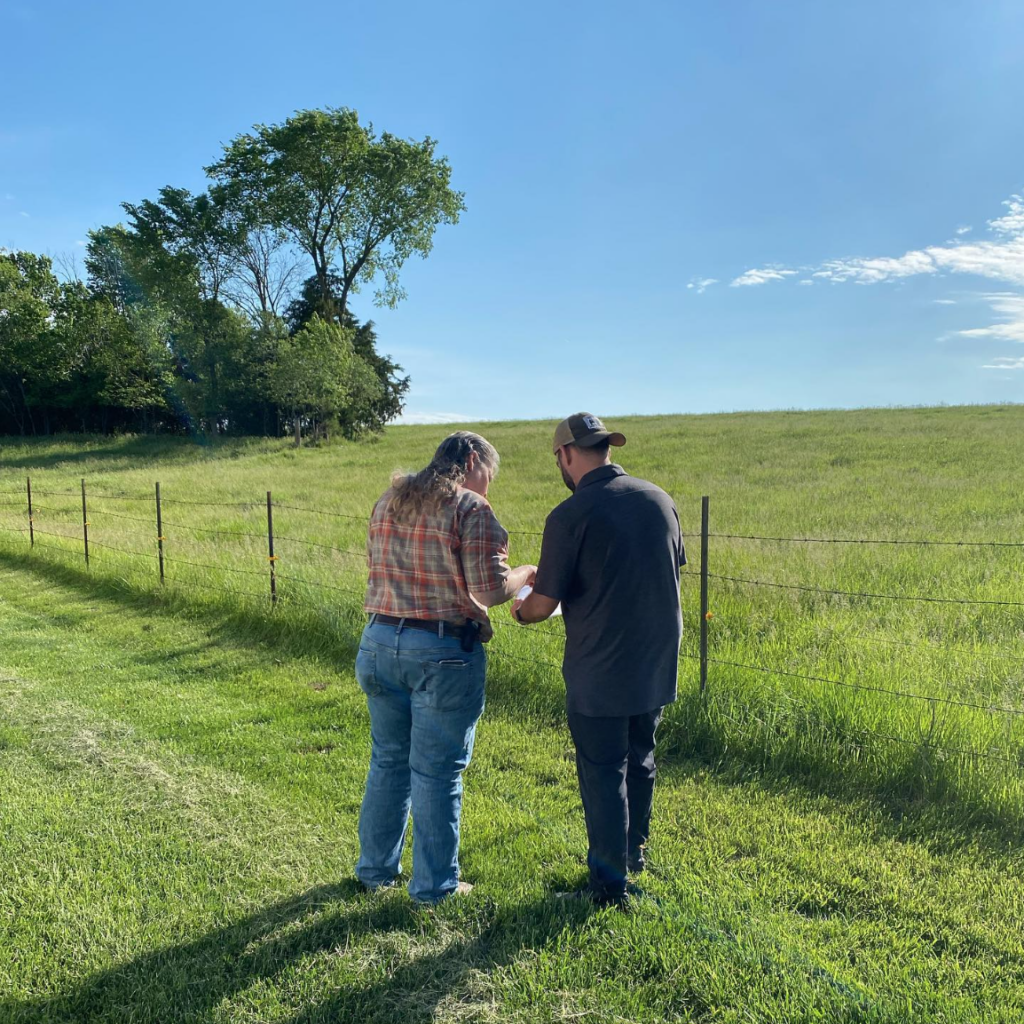
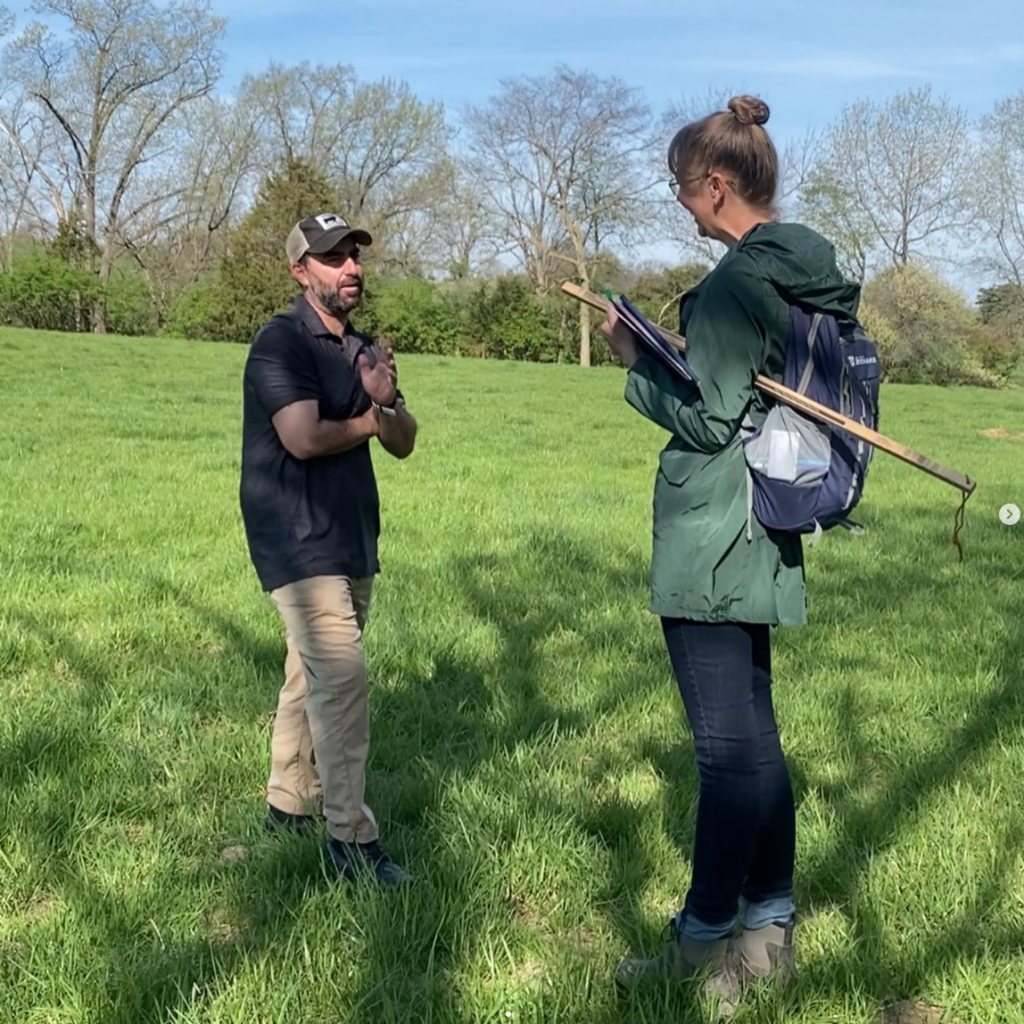
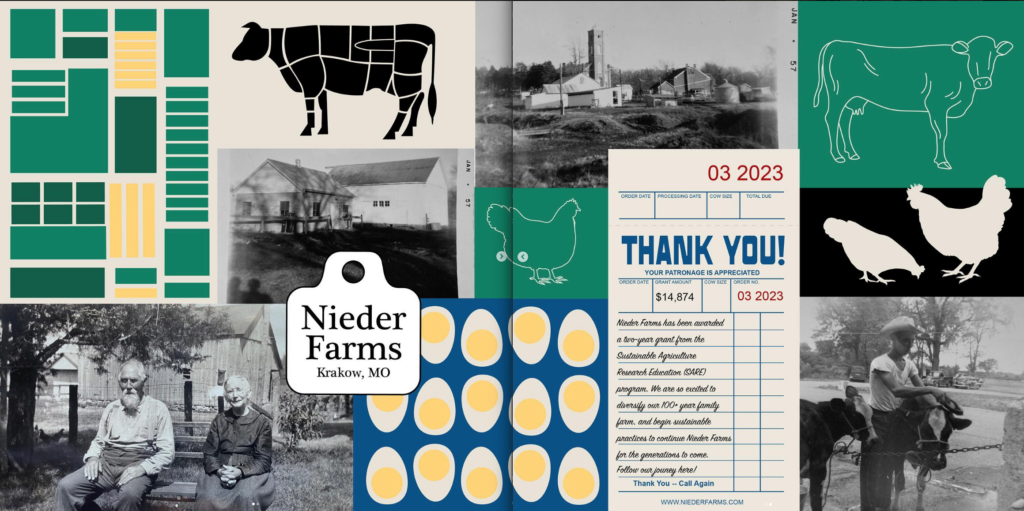
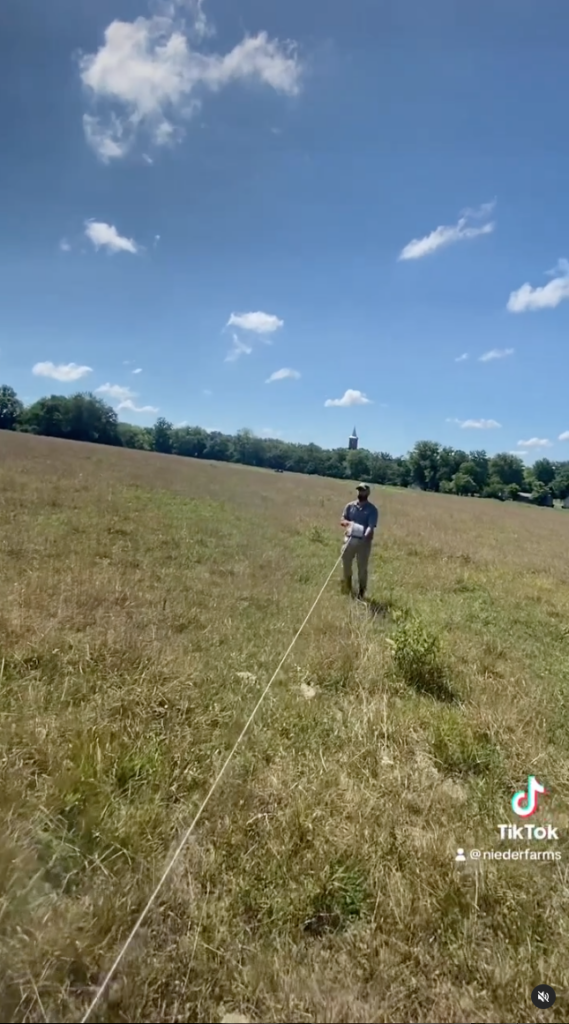
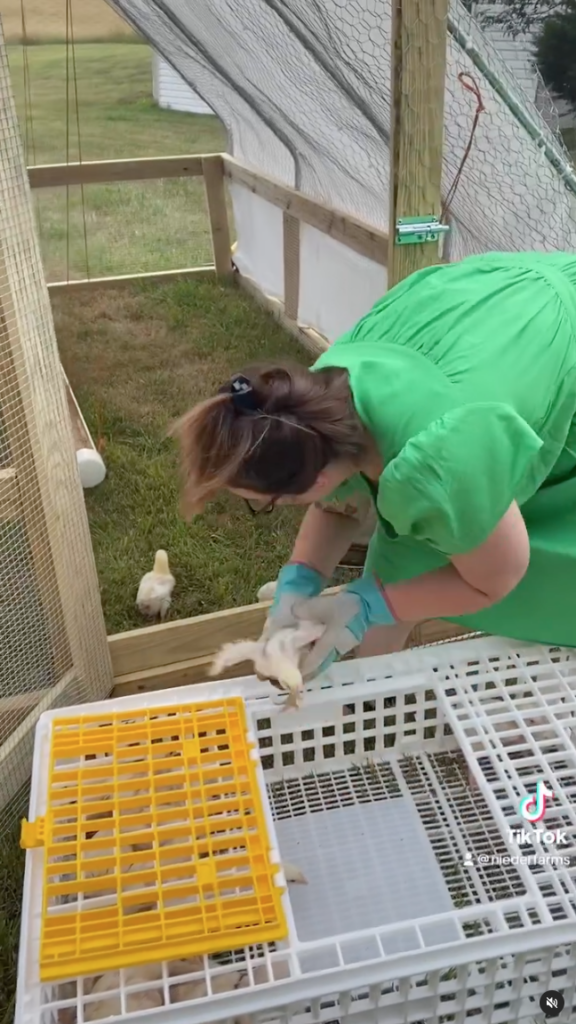
Since it was first year selling pastured poultry, we created a blog post called, "What is Pastured Poultry?" that explained the benefits of pastured poultry, how it's different from what might be in the grocery stores, and why sustainable practices are important.
In the second year, our chicken operation ramped up heavily, and we began receiving more inquiries from customers. To help answer these questions, and save time on our part, we developed an FAQ page on our website highlighting how our chickens are raised, how they can be purchased, and other questions we were getting. This made conversations with customers very efficient. When they inquired about our chickens, we directed them to this page first. Most often than not, their follow up message was to place an order with us. We strongly recommend other farmers do the same.
We also continued making content on our social channels in 2024, offering more insight into our grazing practices and how we raise our chickens. Below are some examples of posts we shared:
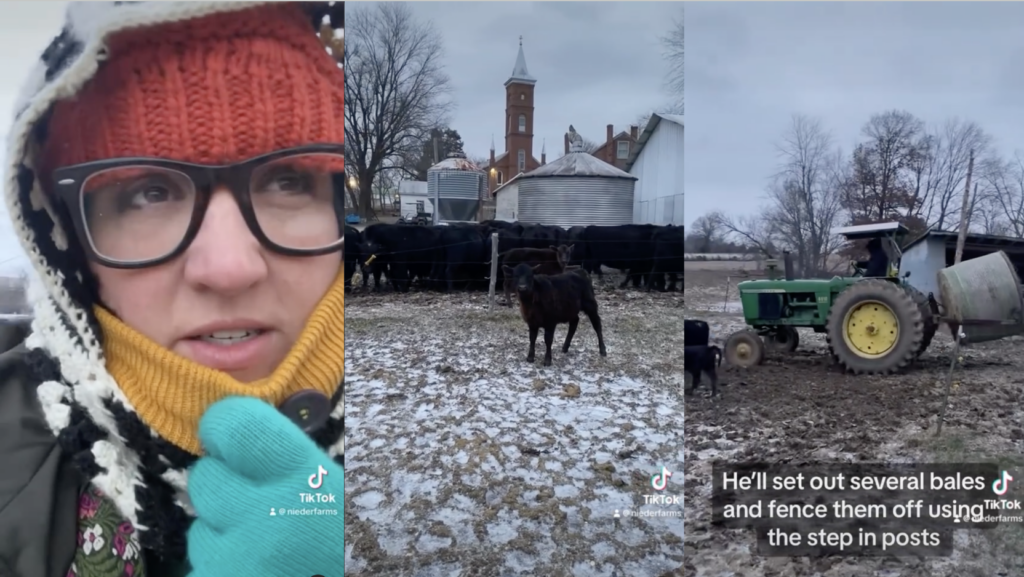
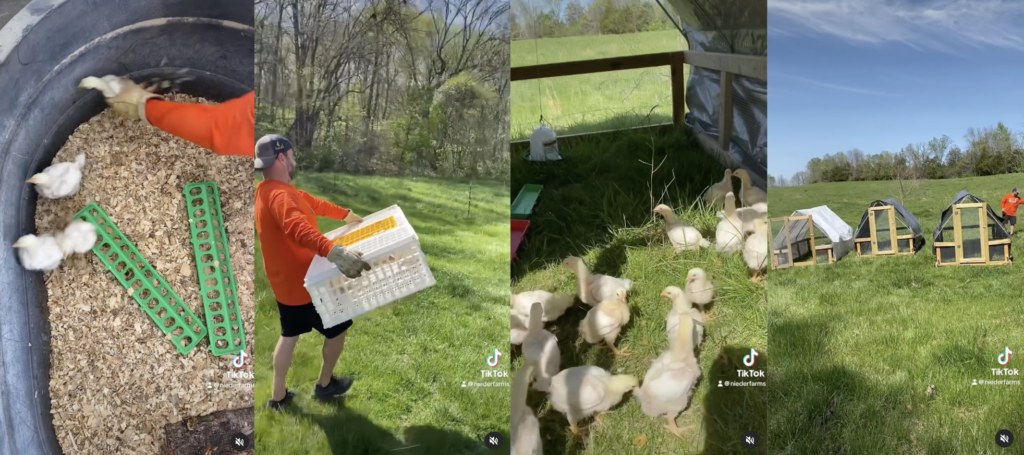
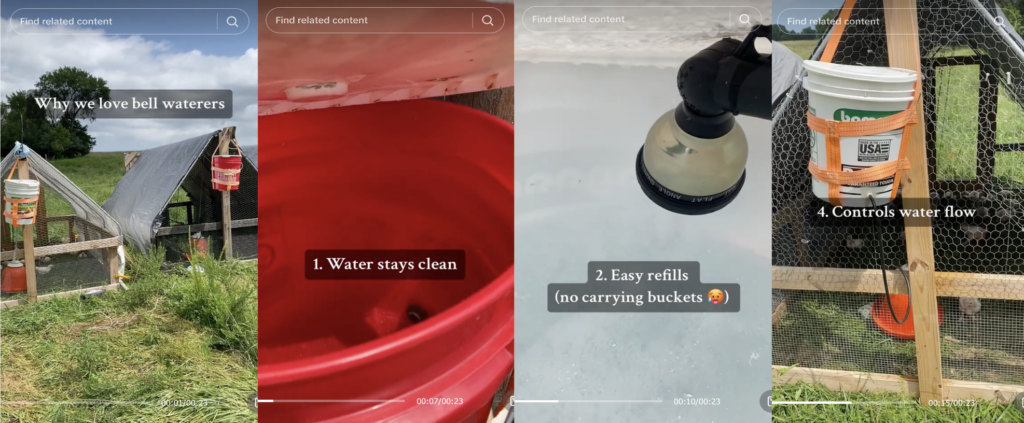
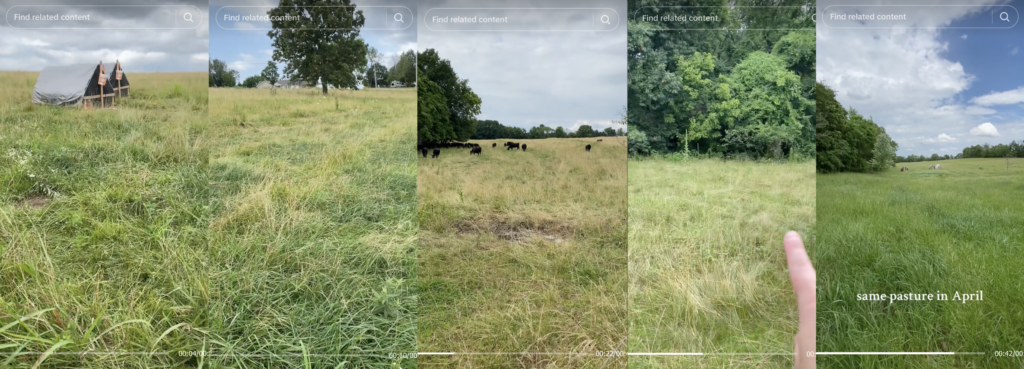
We also hosted four workshops on our farm with the local 4 H groups.
- Pastured Poultry Workshop:
- Attendance: 10
- Date: September 9, 2023
- Surveys: We asked three questions (the same questions) before and after the workshop to ensure the group learned the information. Surveys can be viewed here.
- We hosted 10 people at this workshop, including children and their parents. This is the lesson plan we used for the workshop.
- We began by discussing what they thought pastured poultry was and how it was different from other types of poultry operations. Linked here is a brief presentation we shared with the group. We discussed four main benefits of pastured poultry, and gave some insight into the time it takes to raise the chickens until they're ready for processing.
- After the lesson, we went into the field for a demonstration. We discussed how we built our chicken tractors, and things we like / would do differently the next time around. We talked through how we feed them, how much, and how often. We showed them our water system, and the grass from the prior months' pastured chickens so they could see the difference. The group asked several questions because many were interested in building a tractor for themselves and starting a similar operation. Following this discussion, a few 4H members helped us demonstrate how we move the chicken tractors daily. They helped to feed the chickens, and then move the tractor to a new patch of grass. We did this with two chicken tractors.
- Following the demonstration, we brought the group over to help us build another chicken tractor. Since they were so interested during the demo and asked numerous questions, there wasn't enough time to finish the full tractor. However, we did walk them through the build and tools needed. We also shared several material lists and book recommendations with the group afterward.
- We hosted lunch (pizza, drinks, and snacks) since this was a longer workshop, and many people from the group stayed longer to chat with us and share stories. It was a fantastic community-building event, and the group showed high interest in a chicken processing workshop for the following year.
- We also shared this information on our blog: https://www.niederfarms.com/news/what-is-pastured-poultry.
- Rotational Grazing Workshop
-
- Attendance: 14
- Date: September 30, 2023
- Surveys: We asked three questions (the same questions) before and after the workshop to ensure the group learned the information.
- We hosted 10 people at this workshop, including children and their parents. This is the lesson plan we used for the workshop. Trisha referenced these notes/talking points for the discussion.
- We began this workshop with a group discussion where we shared the benefits of rotational grazing and why we introduced it this year. We covered several topics such as defining rotational grazing, the benefits of it, challenges we faced this year (e.g. a major drought, not having numerous water sources, etc.), as well as some basic tips like knowing when to move the cows, how big to make a paddock, etc. Mike, who managed a lot of the daily logistics for grazing, offered some more detail into things he found difficult and interesting. Overall, our message what that you can have all the information in the world, but the most important thing is to just take a step to get get started.
- We also invited Mary Wolling, a Missouri Extension Office employee, to this workshop since she met with us earlier in the year to teach us about each of the topics. We wanted to introduce her to the attendees to offer another local resource / make a local connection for anyone who wanted to get started.
- After the initial introduction, we took the group into the pasture and showed them how we move the cattle to a new paddock. Mike demonstrated how he reeled up the poly wire and picked up the step in posts, and then reset a new paddock for the following day. During the demonstration the group had several questions (e.g. timing, materials, utilization) and were taking notes.
- Following the pasture demonstration, we walked back to the house for the wrap-up survey, discussion, and snacks.
-
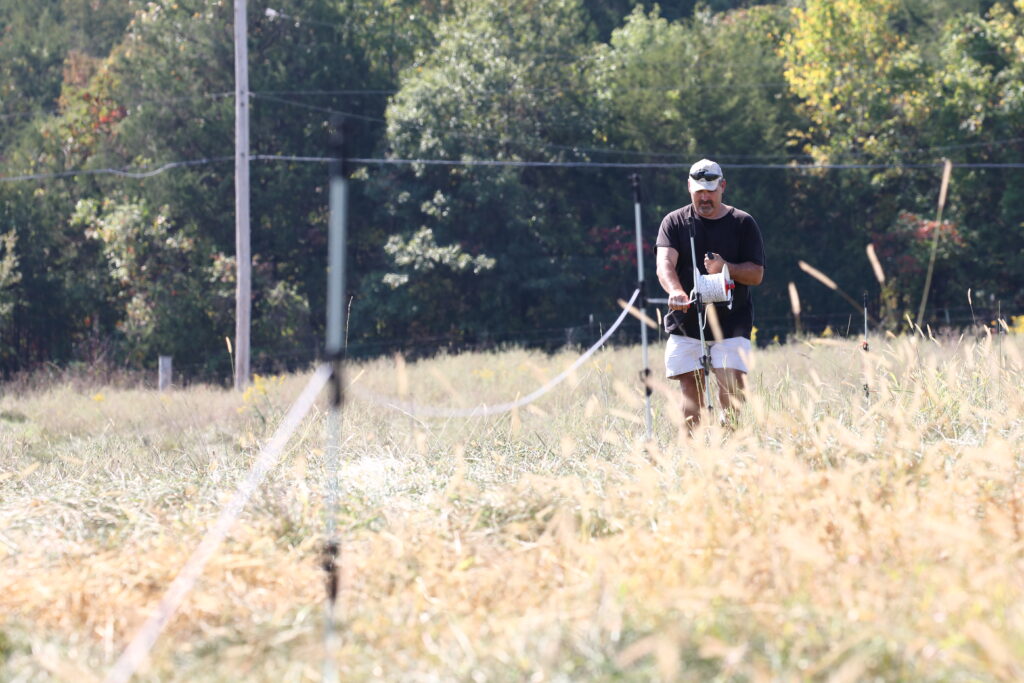
- Orchard Planting Workshop
- Attendance: 7
- Date: Sunday, April 14, 2024
- Surveys: We asked two questions prior to the workshop, and two questions at the end, to gauge comprehension. Can be viewed here and here. We talked about the first questions, and each participant shared their answers, and at the end of the workshop, we did the same with the final questions.
- We hosted 7 people at this workshop, including children and their parents. This is the lesson plan we used for the workshop.
- We began by discussing important things that fruit trees need to grow and be healthy (sunlight, space, water, pollination). We explained that in the year prior, we ran our chicken tractors over this soil to help fertilize it naturally for planting. We demonstrated plant spacing and mapping, and then participants did their own version of a map. Linked here are two worksheets the participants used to understand, light, spacing, and planning how to plant.
- Prior to the lesson, we marked the areas for planting. We demonstrated how to plant a sapling, showing how deep to plant, how to mix the compost and place with the sapling in the hole, how to cover the hole, and how to mulch it. Following this demonstration, each participant received a shovel and used the remaining time to plant the dozen wild plum saplings.
- After planting, the group came together to discuss the workshop, and answer some post-workshop questions, asking what they learned today and why it was important to learn about each tree before planting it.
- We offered water and snacks throughout the workshop as well.
A key learning from planning this workshop is that it was difficult to find local resources (e.g. mentors, experts) to collaborate on the workshop with us. The Master Gardeners and Extension contacts were booked far in advance for other projects, and it was difficult to find community members with the expertise and willingness to present. Although the orchard is a long-term project for our farm, we hope that we can become that local resource for those looking to incorporate fruit trees, diversify their farm, and add another layer to form a more sustainable ecosystem.
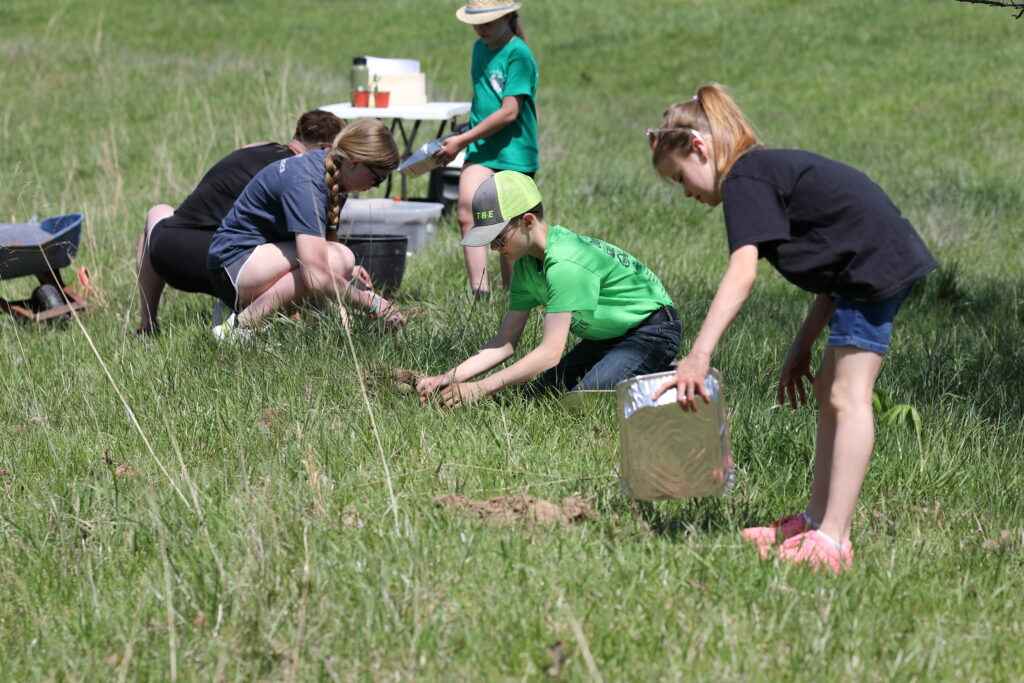
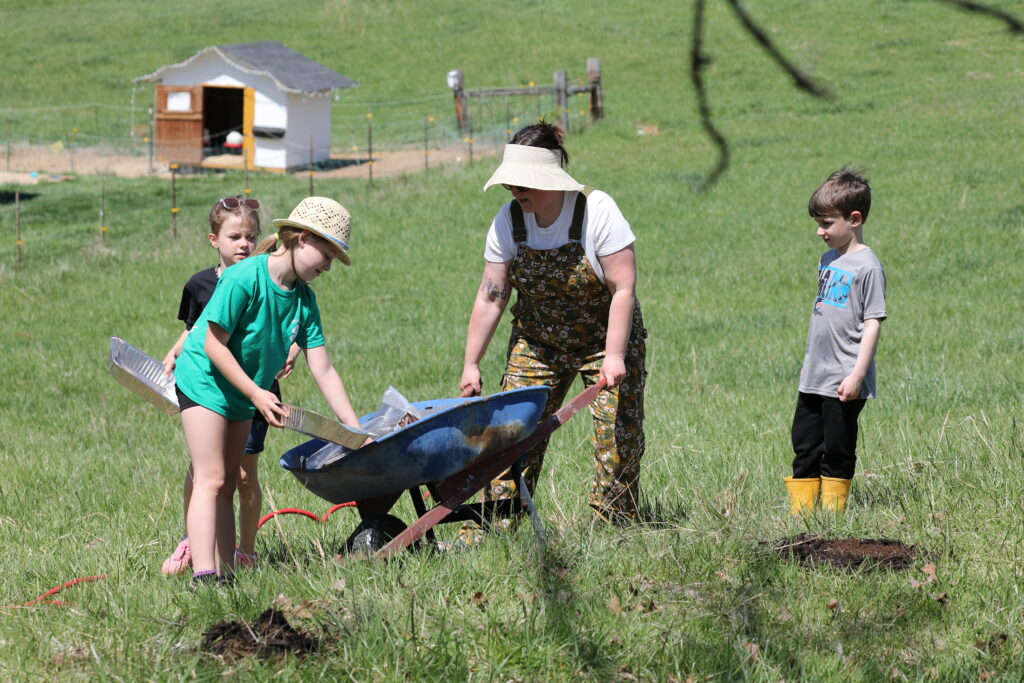
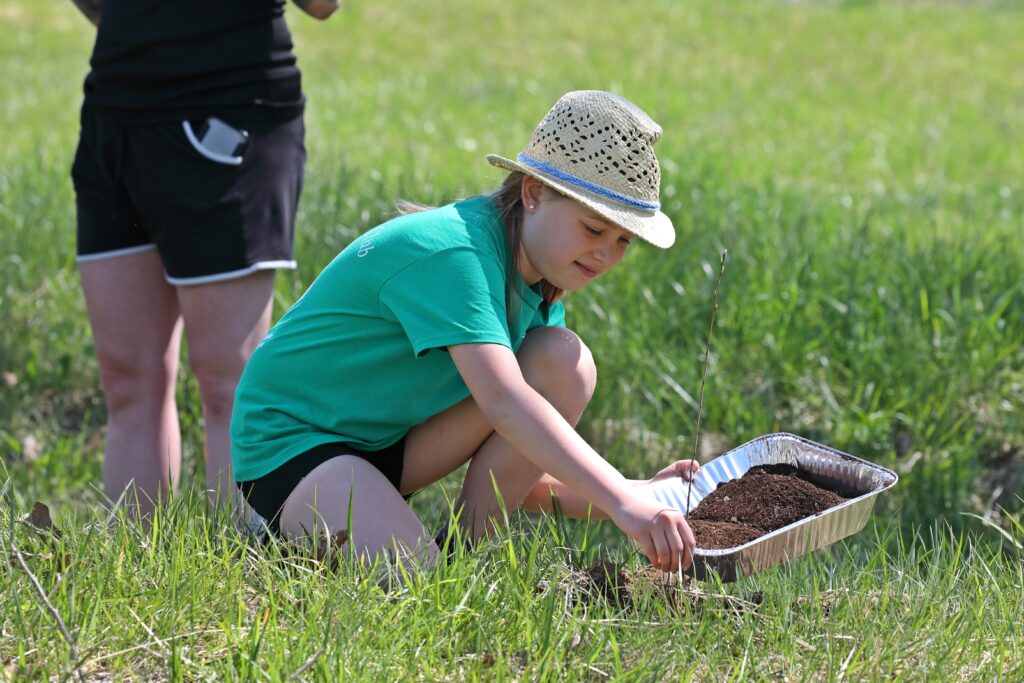
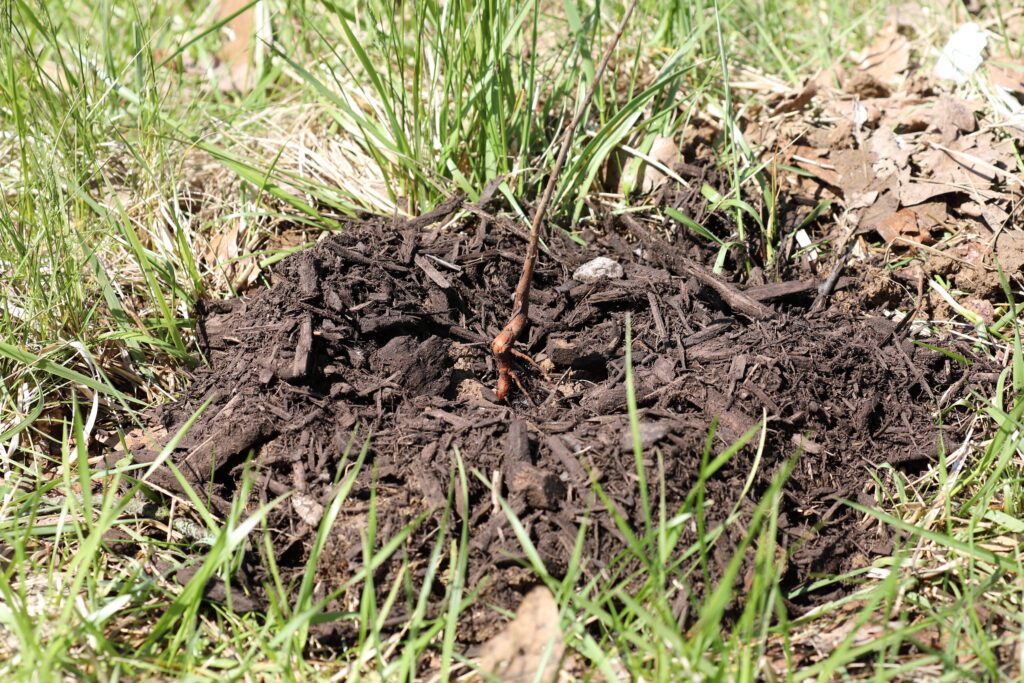
- Chicken Processing Workshop
- Attendance: 12
- Date: Sunday, October 26, 2024
- Surveys: When the workshop began I realized that I printed off the wrong surveys, so we did a group comprehension review instead. We asked what was one thing they learned from the day; what the first step in processing is; why we use a scalder; how long a chicken should rest after processing; and why we sell out chickens whole rather than in pieces. Each of the 4 H participants accurately answered their designated question correctly.
- We hosted 12 people at this workshop, including children and their parents. This is the lesson plan we used for the workshop
- Participants were introduced to the step-by-step process of humane chicken processing, including killing, scalding, plucking, gutting, and packaging. The workshop emphasized the importance of humane treatment, food safety, and how processing ties into sustainable farming practices, such as rotational grazing and pasturing. Through live demonstrations and hands-on learning, attendees gained practical skills and a deeper understanding of ethical and sustainable meat production.
- After processing, the group walked up to see the ~100 chickens that were in their last week on the pasture. We explained how we care for the chickens, and showed the group how we move them across the pasture.
- We offered water and snacks throughout the workshop as well.
The group was very engaged during this workshop, and after sharing some photos on social, we had people reach out to see if we'd host another other one - not just for 4 H, but for anyone who wanted to attend. We processed our first batch of chickens just two years ago, and learned first-hand the various steps from a family member. That person also helps us on processing days, so we had continued guidances in those early days. Based on this workshop, we built out a detailed section with images in our "Startup Guide" since it is an important skill, although one that might be hard to come by. We are considering on-site workshops where participants can learn to process, and take home their whole chicken and/or an online class where we can show the steps for those who need guidance.
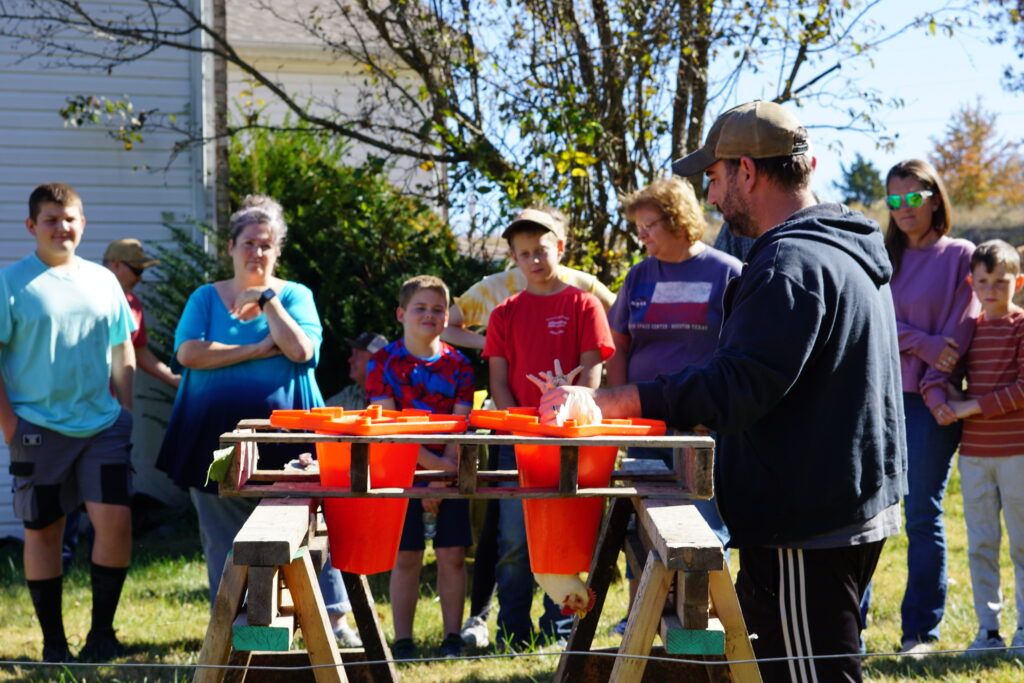
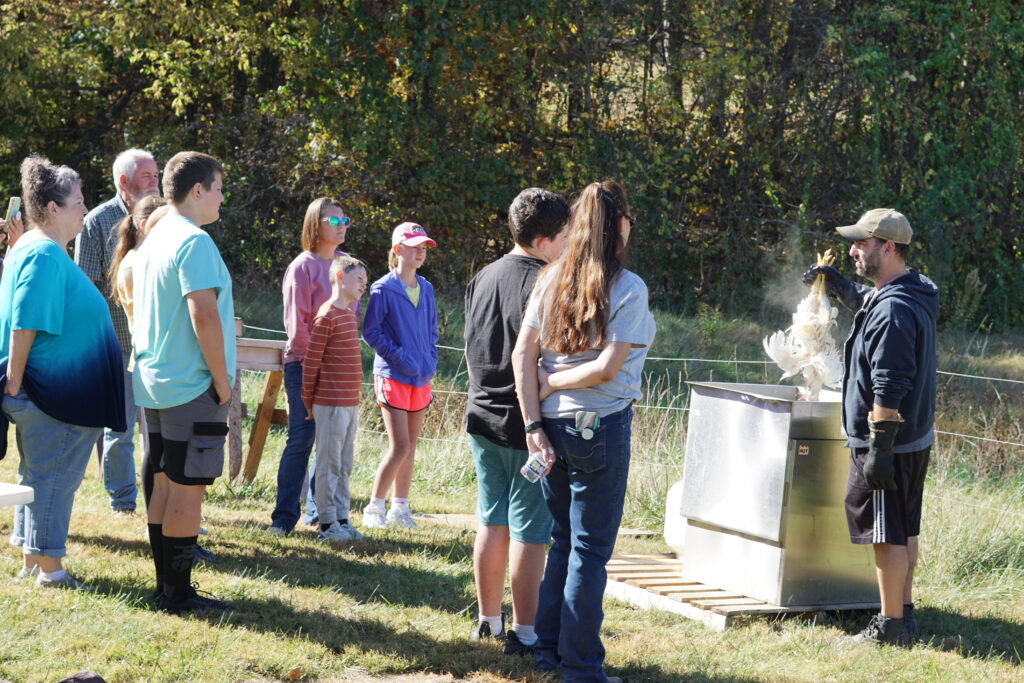
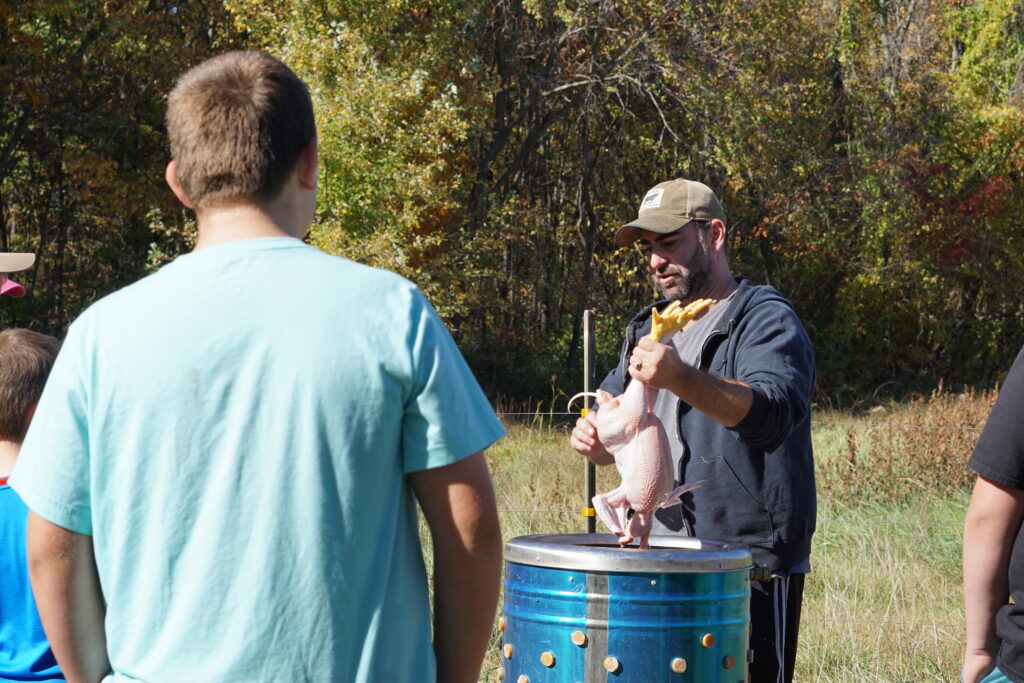
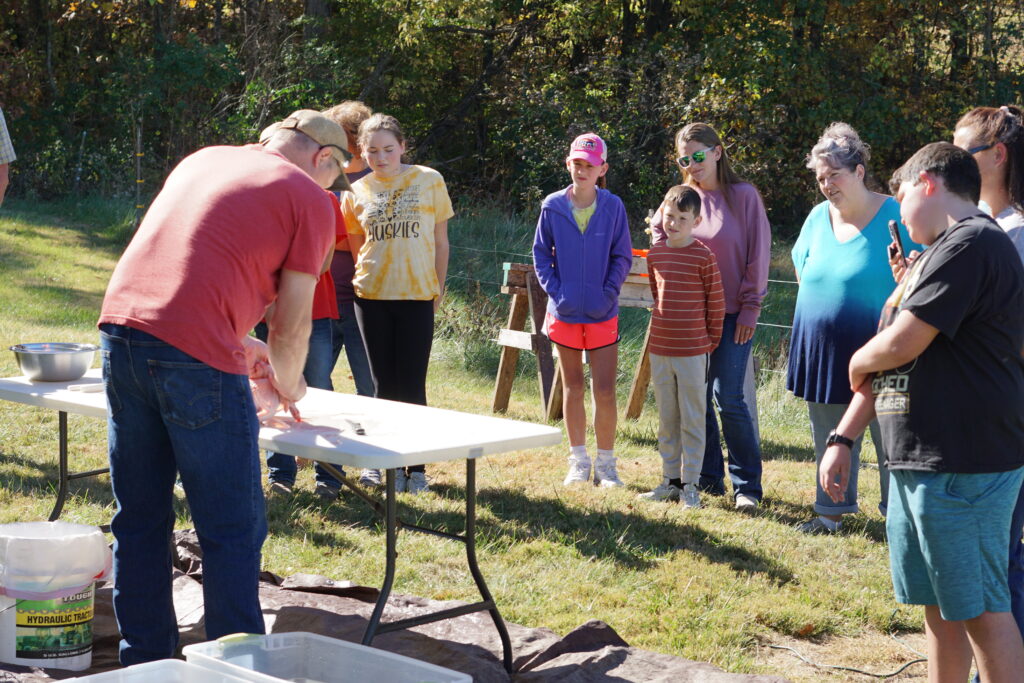
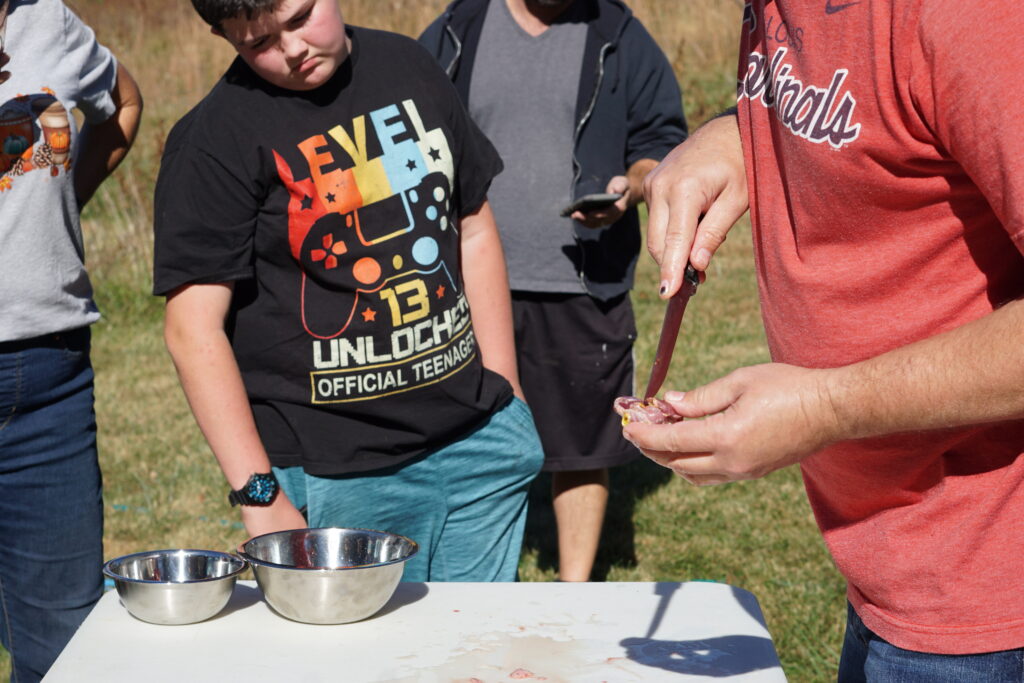
- Startup Guide Outline: In addition to the workshops and content, we've also developed a local "Sustainability Startup Guide," that offers step-by-step instructions and local resources for farmers in/around Franklin County, Missouri.
- The startup guide is broken into six sections: an introduction, grazing, cattle (e.g. freezer beef operation), pastured poultry, orchards, and local resources.
- Each section begins with the equipment needed, gives an overview of the benefits of the practice, and then offers a step by step break down of how to get an operation started, with specific details and tips incorporated throughout.
- The guide took two years to write, and 2-3 months additional to layout in a book format, incorporate photos and illustrations, and print.
- The guide will be printed and distributed locally during our culminating presentation; left at local farm stores and the library; and promoted and distributed digitally via social media so local farmers can gain more exposure/awareness to sustainable practices, and have a free resource to learn more and get started.
Learning Outcomes
Farming is a balance between ambition and adaptability. Starting with small steps—whether it’s a batch of chickens, a few paddocks for grazing, or planting your first orchard—gives you room to learn, make mistakes, and adjust before scaling up. Weather will challenge even the best-laid plans, and perfect conditions are rare, but taking action while being flexible is key.
Rotational grazing, pastured poultry, and orchard establishment each come with unique rewards and challenges, and the right decisions often come down to timing, observation, and a willingness to adapt. Through this project, we’ve learned that success in sustainable farming isn’t about perfection—it’s about persistence, creativity, and finding what works for your land and your goals. Celebrate the small wins, reflect on your progress, and use lessons learned to push forward.
Lessons Learned: Pastured Poultry
- Getting Started
- The SARE grant helped Nieder Farms jumpstart our poultry operation, allowing us to raise and process 438 chickens over two years. In 2023, we began with 25 Cornish Cross chickens to establish baseline costs, feed volumes, and workflows. By 2024, we scaled up production with additional chicken tractors and better processes, identifying bottlenecks and refining efficiencies along the way. By 2024, we raised and processed 358 chickens using additional tractors and optimized workflows.
- Takeaway
- Starting small allowed us to test methods and identify improvements without getting overwhelmed or overusing our resources. For farmers starting their poultry operation, keeping detailed records early on is important to refining your system.
- Processing Bottleneck
- Processing chickens remains the biggest challenge as it is extremely time-consuming. Processing 80–100 chickens takes us two full eight-hour days, requiring a team of at least two-three people. While family and friends occasionally help, the labor intensity limits how many chickens we can process.
- Takeaways
- We’ve decided not to outsource to processors due to the high costs, which would eat into our profits.
- Future plans include setting up a dedicated processing building with more efficient workflows to help with time spent processing, and considering hiring additional help on processing days.
- Affordable Hatchery
- In 2023, we thought that ordering chicks early was essential for securing preferred delivery dates, but that was because we were ordering from hatcheries that offer poultry outside of Cornish Cross. Chick costs ranged from $2.47 to $3.10 per bird, even when ordering in large quantities (i.e. 80+). In 2024, we again placed two pre-orders through those hatcheries at a higher cost per bird because we thought we needed to secure an order vs. risk not having chickens to raise. Mid-year in 2024, we found a reliable hatchery (Welp Hatchery) that only sells Cornish Cross and that could reliably supply chicken at just $2/bird.
- Takeaway
- Researching hatcheries beyond some of the familiar big names and ordering in bulk can significantly reduce input costs. Finding the right supplier is essential to achieving profitability.
- Overlapping batches also improved efficiency. Since chicks need two weeks in the brooder and 4–5 weeks on the pasture, staggering batches by four weeks instead of six allowed us to maintain an ongoing rotation and raise higher quantities in 2024.
- Selling Price and Profits
- In 2023, we sold chickens at $5/lb, which resulted in slower sales and customer feedback about pricing. In 2024, we adjusted to $4/lb to align better with the local market, resulting in higher sales volume and improved customer satisfaction. Despite lowering the price, our profitability increased due to:
- Decreasing input costs per bird: Reduced from $8 in 2023 to $7 in 2024.
- Increasing average bird weight: From 3.5 lbs in 2023 to 4–5 lbs in 2024.
- With these refinements, our poultry operation generated $3,200 in revenue in 2024—up significantly from the small profits in 2023. Reinvesting profits into additional chicken tractors helped us scale from one tractor in 2023 to four in 2024, boosting our capacity and efficiency.
- Takeaways
- Know your market: Aligning your pricing with local demand can improve sales volume and customer satisfaction.
- Track and optimize costs: Lowering input costs and improving efficiencies can sustain profitability, even at reduced prices.
- Invest in scalability: Especially in the early years, reinvesting early profits into infrastructure (e.g. additional chicken tractors) lays the groundwork for future growth and increased revenue.
- Leverage small wins: Small improvements, like optimizing feed usage and bird weight, can compound into meaningful financial gains over time.
- In 2023, we sold chickens at $5/lb, which resulted in slower sales and customer feedback about pricing. In 2024, we adjusted to $4/lb to align better with the local market, resulting in higher sales volume and improved customer satisfaction. Despite lowering the price, our profitability increased due to:
- Brooder Management
- In 2023, we learned the hard way how important it is to set up the brooder properly. Overcrowding caused some chicks to grow unevenly, and we lost eight birds in the first batch. By 2024, we made some simple but effective changes:
- Added more feeders and waterers so all the chicks had easy access to food and water.
- Kept an eye on the weather and only moved chicks to the pasture at two weeks when the conditions were right—delaying if there was rain or a cold snap coming.
- Takeaway
- These changes made a big difference, and we lost fewer than five chicks per batch in 2024. Taking the time to set up a good brooder and paying attention to the little details early on makes a huge impact on chick health and survival.
- In 2023, we learned the hard way how important it is to set up the brooder properly. Overcrowding caused some chicks to grow unevenly, and we lost eight birds in the first batch. By 2024, we made some simple but effective changes:
- Accounting for Loss
- Losing chicks is just part of raising poultry—especially when you’re getting started. In 2023, we lost eight birds in our first batch. Thankfully, the hatchery refunded us for the losses, but it meant we had fewer chickens to sell. By the second year, we learned to order 5–10 extra birds per batch to account for losses.
- Takeaway
- It’s a good idea to plan for losses when ordering chicks. Most hatcheries send a few extras, but adding a buffer ensures you meet your sales goals even if some don’t make it.
- Measuring Feed Per Chicken
- From the start of our operation, we kept close track of how much feed each batch of chickens ate. In 2024, we found that 12–16 pounds of feed per bird was the sweet spot for getting them to our target weight of 3.5–5 pounds in six weeks. A few things that helped:
- Buying feed in bulk saved us $26 per batch of chickens.
- Managing feed better (avoiding overfeeding or waste) cut costs and made feeding more efficient.
- Takeaway
- Tracking how much feed your chickens eat is worth the effort. It helps you fine-tune costs and make sure your birds are growing properly, which directly impacts your bottom line.
- From the start of our operation, we kept close track of how much feed each batch of chickens ate. In 2024, we found that 12–16 pounds of feed per bird was the sweet spot for getting them to our target weight of 3.5–5 pounds in six weeks. A few things that helped:
- Turkeys
- At first, we thought we’d raise turkeys alongside chickens, but we realized pretty quickly it wouldn’t work out. Turkeys take longer to mature and eat a lot more feed, which would cost us $50–$60 per bird. Selling them at that price just wasn’t realistic for our area.
- Takeaway
- Focusing just on chickens allowed us to get the most out of our time and resources. Before committing to raising multiple types of poultry, it’s important to run the numbers and make sure it’s worth it. For us, sticking to chickens was the better choice.
-
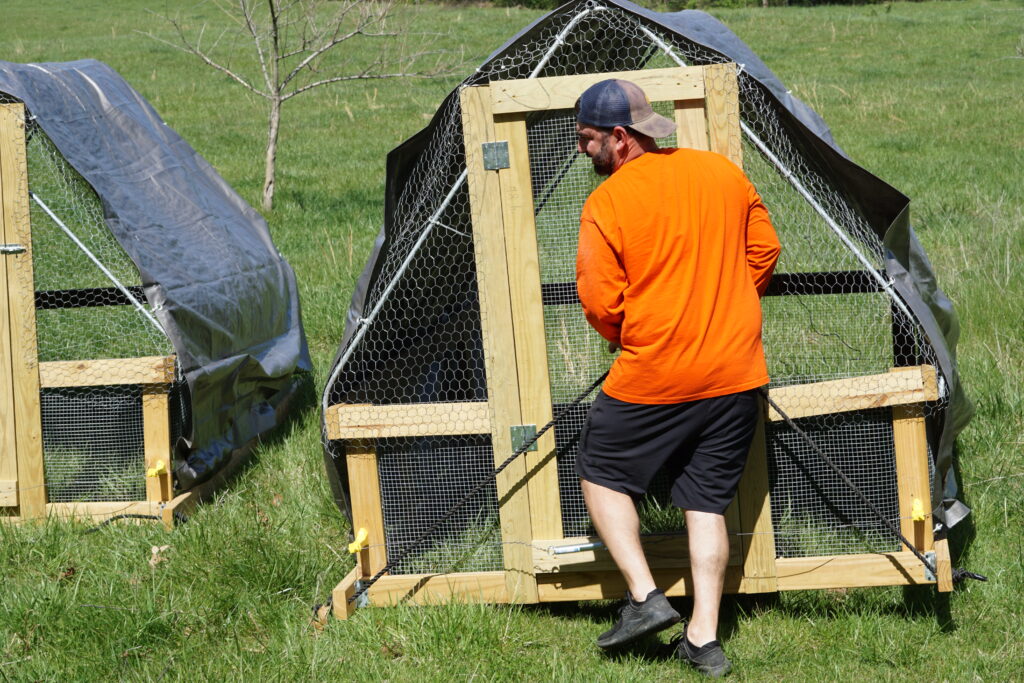
Pulling chicken tractors through the pasture in early spring. 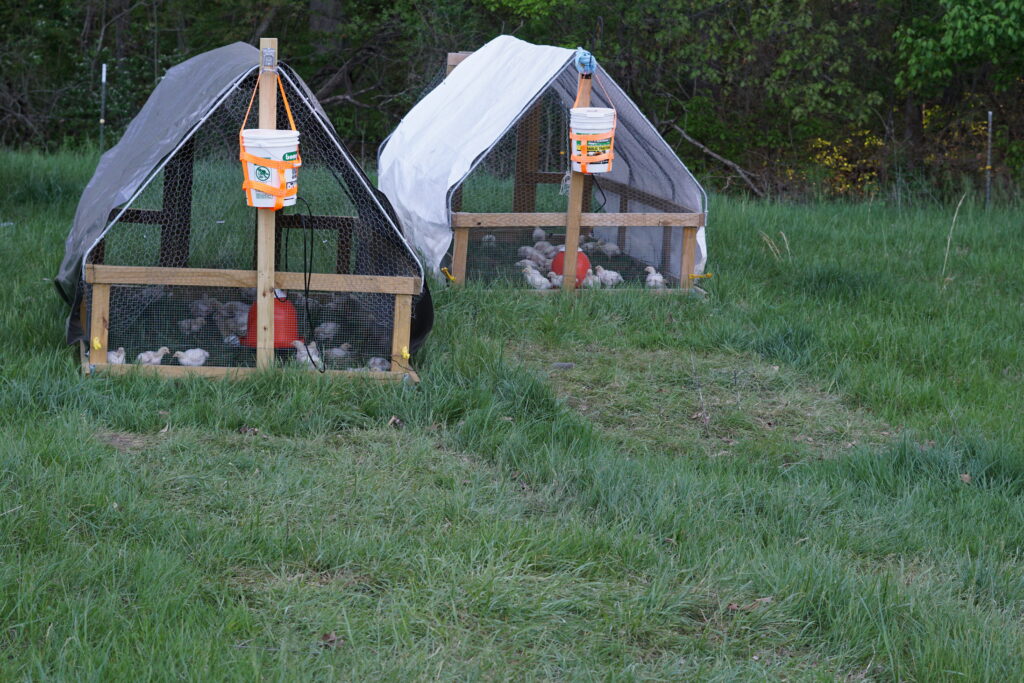
Fertilized patches of grass, left after moving the chicken tractors daily. 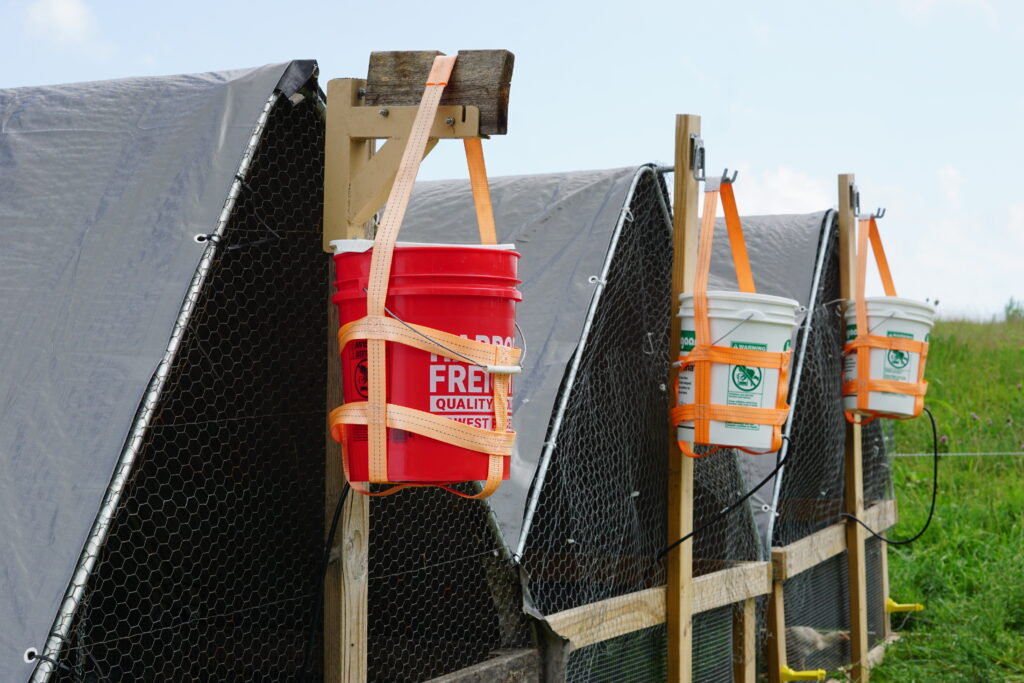
We utilized bell waterers, which always made fresh water readily available and allowed us to refill without needing to enter the tractor or carry buckets/waterers for long distances. We simply filled them with a hose.
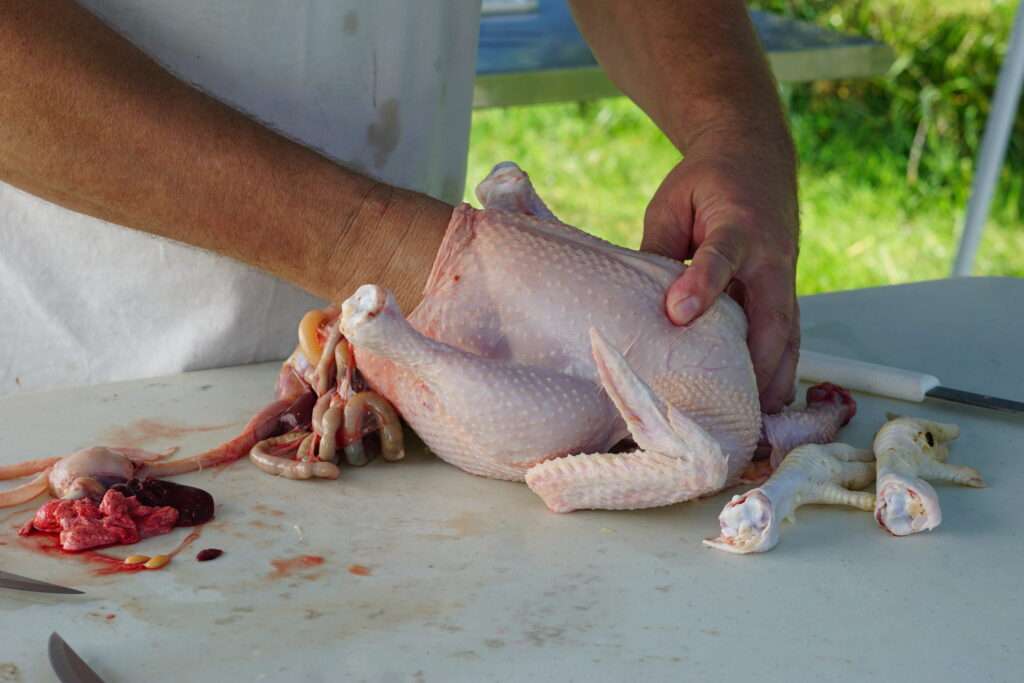
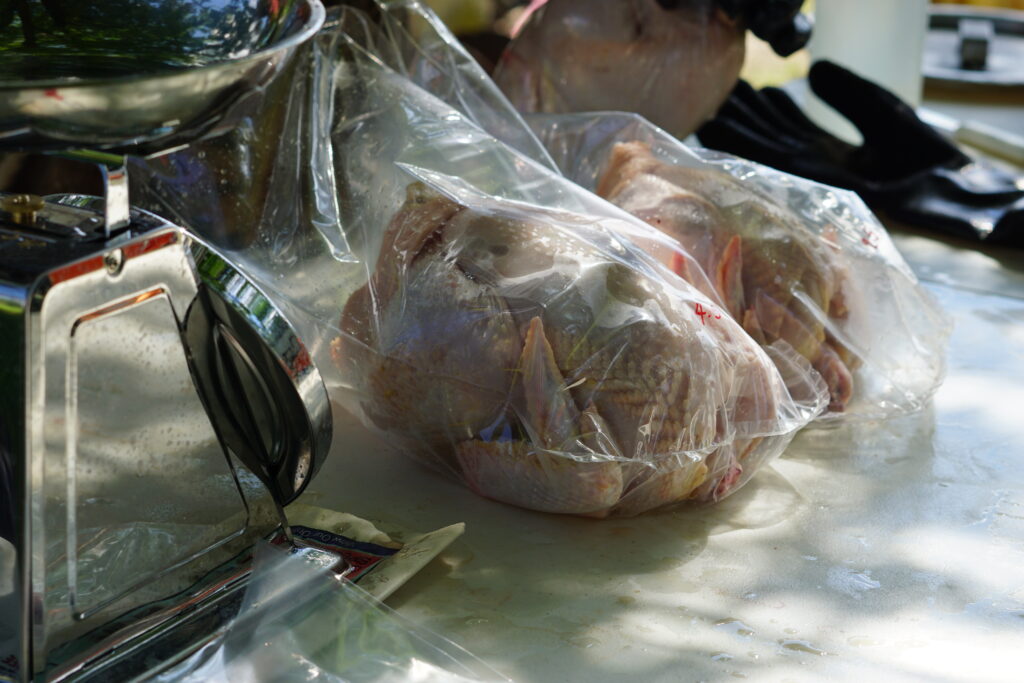
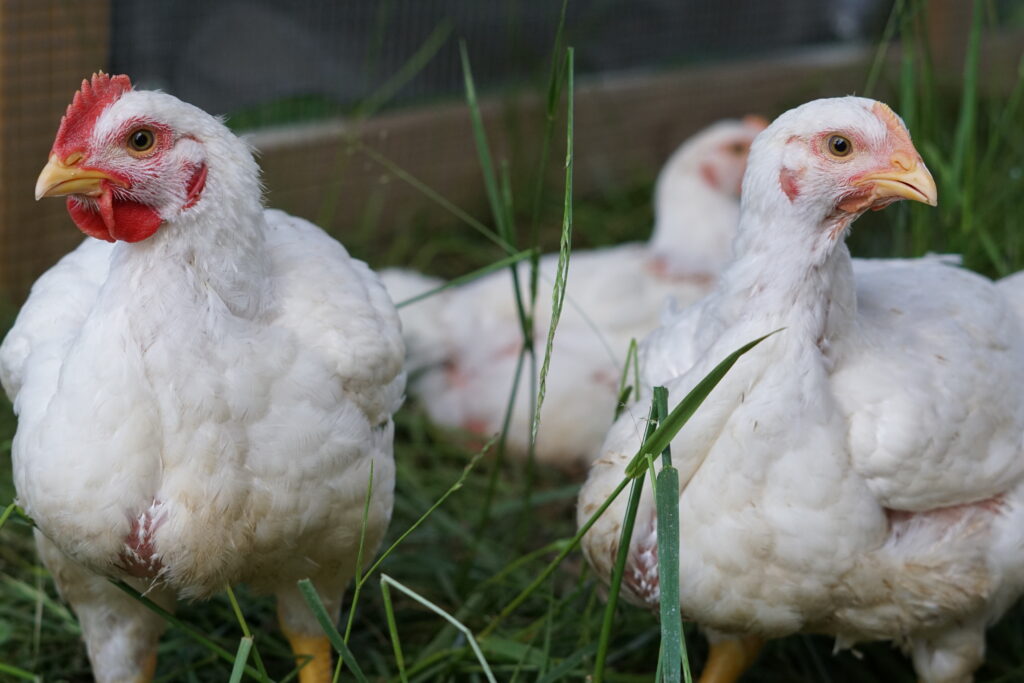
Lessons Learned: Rotational Grazing
- Getting Started Without Full Infrastructure
- Starting small was crucial, even without ideal infrastructure. In 2023, we worked around limited water access by arranging paddocks so cattle could backtrack to a central water source. This allowed us to begin rotational grazing without the upfront expense of installing water throughout the farm. In 2024 we still didn’t have a second water source, but were able to improve grazing further by incorporating more, smaller paddocks and rotations with strip grazing. It also helped that in 2024 we could start immediately, whereas in 2023 we started mid-year due to a drought and because it was our first time setting it up.
- Takeaway
- You don’t need everything to be perfect to get started. Start small, work with what you have, and make improvements as you go. Even basic changes can make a big difference.
- Extending the Grazing Season
- In 2023, rotational grazing allowed us to graze into mid-November, which was later than in previous years. By 2024, we stretched the grazing season even further, all the way to December 20, thanks to better paddock rotation and monitoring. This saved us 60 bales of hay that we didn’t need to use early in the winter.
- In 2024, we also began experimenting with stockpile grazing by leaving some paddocks ungrazed during late summer and early fall. This strategy provided additional forage for winter grazing, further reducing hay dependency by 60 bales that we didn’t need to use early in the winter.
- Takeaway
- Rotational grazing, combined with stockpile grazing, can significantly extend the grazing season and reduce hay usage. These practices not only lower costs but also give pastures more time to recover, contributing to greater sustainability, improved forage utilization, and long-term efficiency.
- Improving Soil & Forage
- Rotational grazing and integrating chicken tractors into the pasture enhanced soil health and forage regrowth:
- Grass Resilience: Grass regrew faster, even during drought conditions, due to consistent grazing intervals and a maintained canopy that reduced moisture loss and soil erosion.
- Manure Distribution: Moving cattle daily spread manure evenly, naturally fertilizing the soil and improving organic matter and nutrient levels.
- Chicken Contributions: Chickens added an extra layer of nutrients, further enriching the soil. This dual grazing system supported healthy forage regrowth and soil structure. However, it also increased weed growth in areas like the orchard, requiring more management.
- Takeaways
- Combining rotational grazing with chicken tractors creates a synergistic effect, improving soil health and forage growth. However, managing weed growth in sensitive areas like orchards is essential.
- Rotational grazing and integrating chicken tractors into the pasture enhanced soil health and forage regrowth:
- Optimizing Forage Utilization
- Strip grazing in 2024 increased forage utilization by encouraging cattle to consume a balanced mix of grasses and legumes before moving to the next paddock. This eliminated the need for supplemental feed, which had been necessary in 2023 when cattle consumed the most nutrient-rich forage first and left only roughage.
- Takeaway
- Tight paddocks and frequent rotations maximize forage use, improve cattle nutrition, and reduce supplemental feed costs.
- Soil Health Improvements
- Grazing in wetter conditions can lead to soil compaction, a challenge we faced in the winter of 2023 and throughout 2024. To address this, we adjusted grazing schedules to avoid moving cattle immediately after heavy rains or during winter storms that left the ground saturated. This change helped reduce compaction and protect root systems, an issue we struggled to manage effectively before rotational grazing.
- Soil tests from 2022–2024 showed that rotational grazing contributed to measurable improvements:
- Organic Matter (OM): Rebounded from 3.0% in 2023 to 4.0% in 2024, surpassing 2022 levels. This recovery reflects the benefits of manure distribution, unrolled hay applications, and consistent grazing management.
- CEC (Cation Exchange Capacity): Improved to 12.6 meq/100g in 2024, approaching the 2022 baseline of 14.4 meq/100g after a drop in 2023. This indicates better nutrient retention and soil resilience.
- Takeaway
- Rotational grazing plays a crucial role in stabilizing and improving key soil health metrics. By reducing compaction, evenly distributing nutrients, and maintaining organic matter, these practices enhance forage growth, support pasture recovery, and build long-term soil productivity.
- Water Source Accessibility
- Limited water infrastructure required cattle to backtrack to a central water source. This worked in the short term, but led to uneven pasture utilization near the water point.
- Takeaway
- Developing portable or distributed water systems in the future would allow for more consistent grazing patterns and reduced stress on the herd.
- Incorporating Diverse Forage
- Extreme weather conditions in 2023 and 2024 required us to adapt our forage improvement strategy to optimize long-term results without risking wasted seed or resources.
- 2023: Severe drought made seeding unfeasible, as germination would have been nearly impossible due to the lack of moisture.
- 2024: Heavy spring rains caused significant soil erosion and ruts in the pasture, further delaying planting plans.
- Despite these setbacks, soil test results from 2022–2024 reveal key improvements in soil health metrics:
- Organic Matter (OM): Increased from 3.0% in 2023 to 4.0% in 2024, surpassing 2022 levels. This reflects the benefits of rotational grazing, consistent manure distribution, and unrolled hay applications.
- Cation Exchange Capacity (CEC): Recovered to 12.6 meq/100g in 2024 after dropping to 9.3 meq/100g in 2023, approaching the 2022 baseline of 14.4 meq/100g. This improvement indicates better nutrient retention and soil resilience.
- These positive trends suggest that our grazing practices provided a strong foundation for soil recovery, even without planting. However, we recognize the opportunity to further enhance soil health and forage productivity through the introduction of diverse forage species.
- Plan for 2025: We will be incorporating the below legumes and grasses into our planting in spring of 2025:
- Forage Mix: Legumes: Red and white clover for nitrogen fixation and improved forage quality.
- Grasses: Orchard grass, timothy, and fescue to enhance organic matter, control erosion, and balance forage diversity.
- Takeaway
- The soil test data confirms that delaying seeding in unfavorable conditions was the right decision, as soil health improved through rotational grazing and nutrient distribution. Moving forward, the planned incorporation of legumes and grasses will build on these gains, creating a more nutrient-rich and resilient pasture while maximizing productivity.
- Extreme weather conditions in 2023 and 2024 required us to adapt our forage improvement strategy to optimize long-term results without risking wasted seed or resources.
-
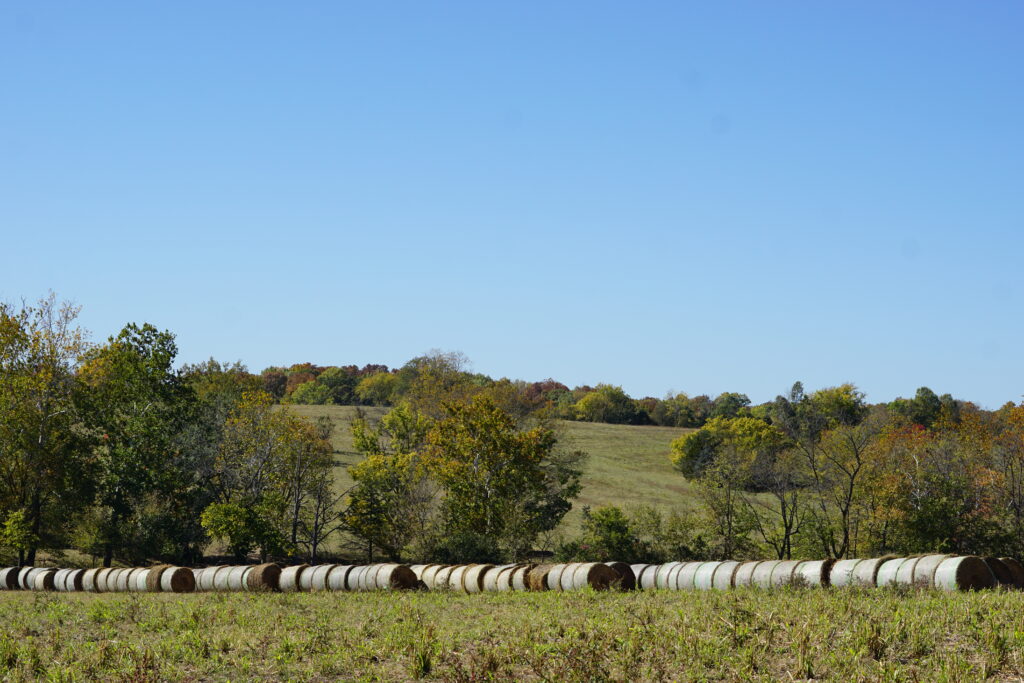
Although we still rely on hay and will still supplement in the winter, our hay usage has reduced since we began in 2023.
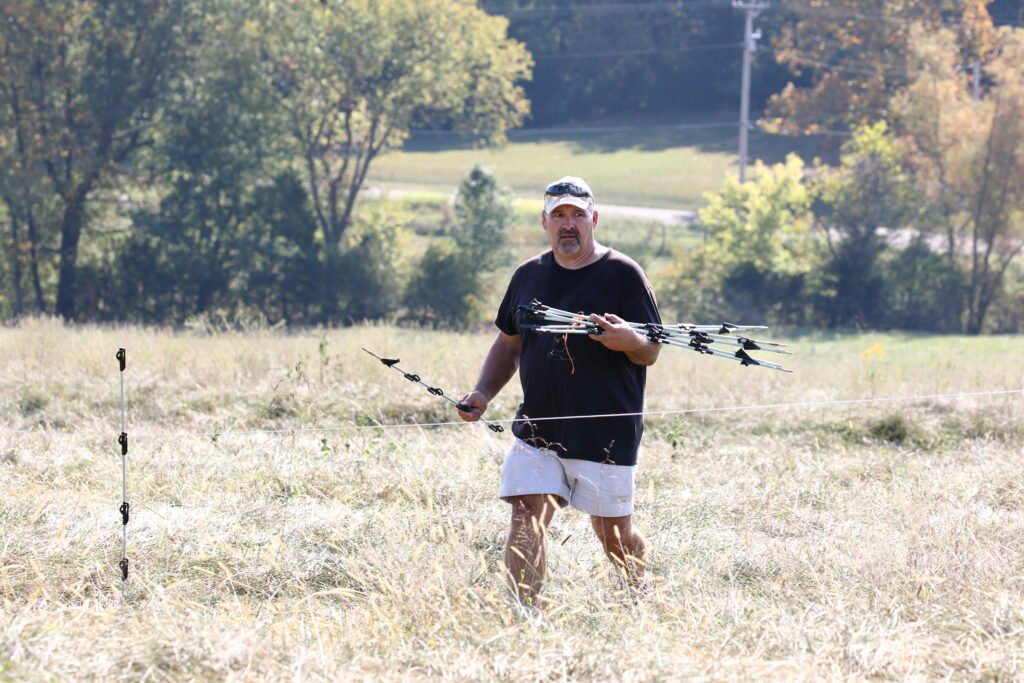
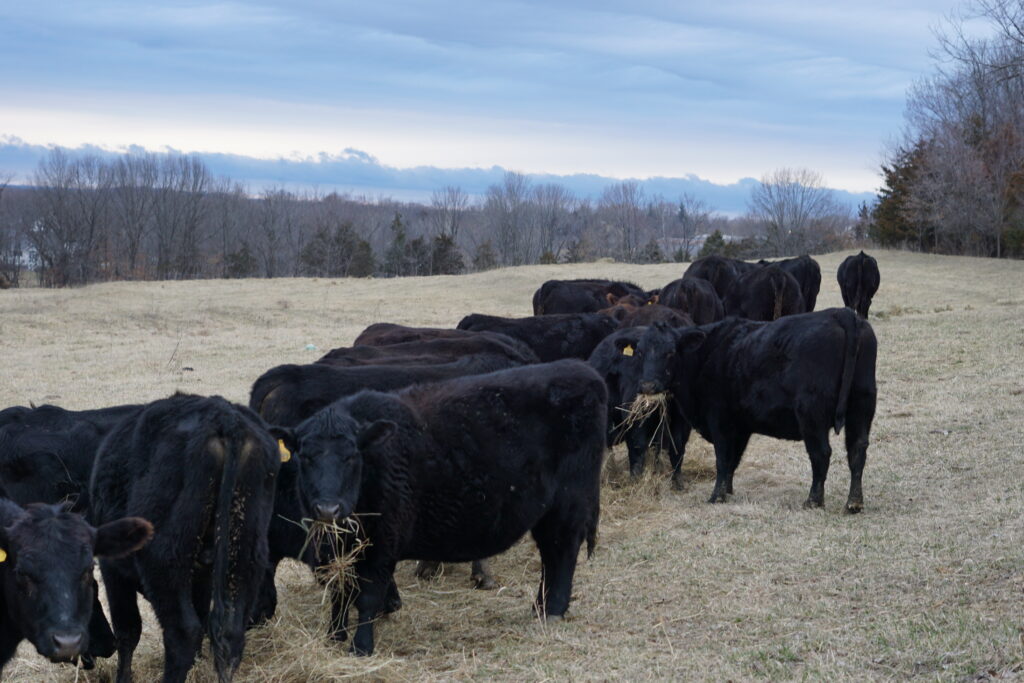
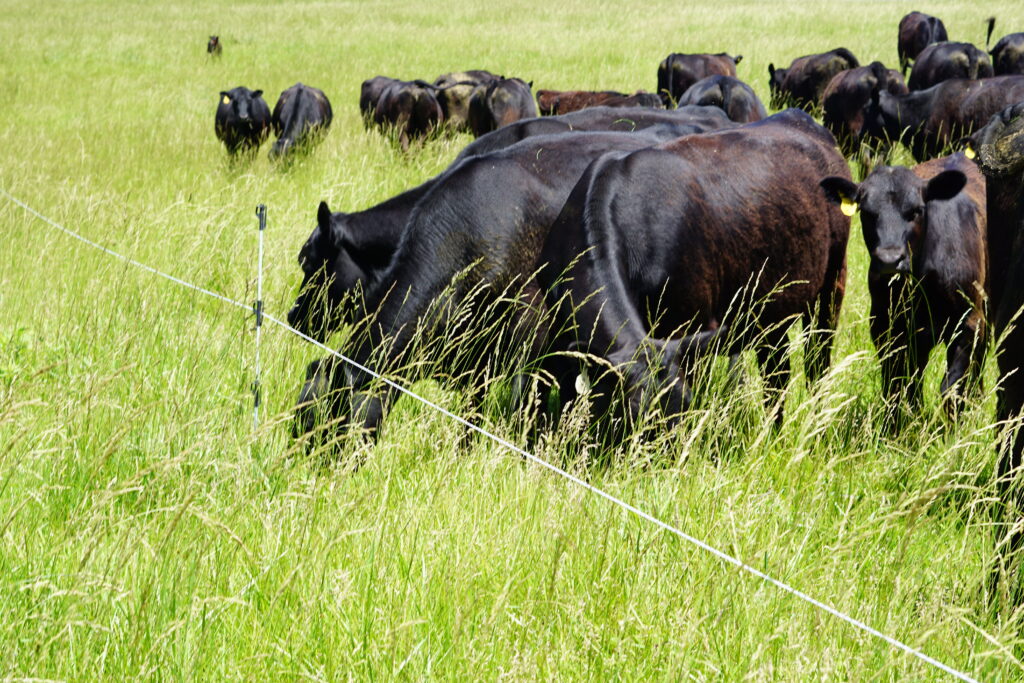


Lessons Learned: Establishing an Orchard
- Challenges in Finding Guidance
- Starting an orchard turned out to be much more challenging than anticipated, largely because local guidance was hard to come by. While visiting a you-pick orchard and talking to its owners provided a helpful starting point, most of what we learned came from self-directed efforts like completing the Missouri Master Gardener course, consulting Missouri Extension Office resources, and absorbing information from books, podcasts, and social media. Even with these resources, certain practices like pruning remained unclear, and required additional trial and error this winter.
- Starting Too Big
- We planted 80 saplings in our first year, which was an overwhelming undertaking for beginners. Initially, we potted the saplings to keep them healthy, but planting them over the course of a month made it clear we had bitten off more than we could chew. If we could start over, we would begin with fewer trees, giving us time to learn through experience and maintain them more effectively.
- Planning and Spacing Challenges
- Orchard planning required far more thought and effort than we expected. Key considerations included:
- Ensuring proper spacing for each variety.
- Designing rows wide enough to accommodate equipment like tractors and chicken tractors.
- Assessing pasture conditions to find the best spots for planting.
- While these efforts were necessary for long-term functionality, they were time-intensive and often felt overwhelming. We were in the pasture with measuring tape and spray paint marking off areas, and then working to translate them to a map - and back again. Often it felt like we were figuring it out as we went along through trial and error rather than having the proper tools and guidance readily available.
- Orchard planning required far more thought and effort than we expected. Key considerations included:
- Watering System Shortcomings
- One of our biggest challenges was the lack of a dedicated watering system. We relied on a 50-foot hose (two 25 foot hoses, connected) to water trees individually, which was both inefficient and labor-intensive.
- A simple irrigation or drip system would have saved significant time and ensured consistent watering, especially during dry periods.
- This is now a top priority as we work on the orchard again in 2025.
- Grazing and Weed Management
- To protect the saplings, we fenced off the entire orchard area from cattle grazing. However, this approach came with trade-offs:
- Running chicken tractors through the orchard offered natural fertilization but also increased weed and tall grass growth due to reduced grazing pressure.
- The competing vegetation made it difficult to maintain saplings, particularly for less resilient varieties like pawpaws, hazelnuts, and pecans.
- Although we mulched, we didn’t lay enough to suppress the surrounding weed and grass pressure.
- To protect the saplings, we fenced off the entire orchard area from cattle grazing. However, this approach came with trade-offs:
- Overwhelming Scope of Work
- Taking on the orchard while simultaneously starting a chicken operation and implementing rotational grazing was, in hindsight, too much to manage at once. The orchard often got the short end of the stick because it wasn’t a “living animal” requiring daily attention. The sheer volume of moving parts made it hard to prioritize, and orchard tasks frequently fell by the wayside when other areas usually demanded immediate action.
- Sapling Survival Rates
- By December 2024, survival rates varied from 10-60% across the six species we planted:
- Elderberry and blackberry saplings showed the most resilience, thriving in local conditions with minimal intervention.
- Hazelnuts and pawpaws struggled, primarily due to weed competition and waterlogging from heavy rains.
- Moving Forward: Lessons and Adjustments
- Despite the challenges and labor-intensive nature of orchard management, we remain committed to its long-term benefits. The orchard aligns with our broader goals, including:
- Generating a new revenue stream.
- Improving soil health and sequestering carbon.
- Reducing erosion and retaining topsoil as weather becomes more unpredictable.
- Providing shade for chickens during increasingly hot summers.
- Moving toward a more closed-loop system with fewer external inputs.
- Despite the challenges and labor-intensive nature of orchard management, we remain committed to its long-term benefits. The orchard aligns with our broader goals, including:
- Future Plans (2025 and Beyond)
- Replanting efforts will focus on elderberries, blackberries, and mulberries (we had some already growing on the farm), which were the most forgiving and well-suited to our conditions.
- We’ll incorporate permaculture techniques, such as heavy mulching, to improve water retention, reduce weed pressure, and support sapling growth.
- We’ll experiment with protecting individual trees while allowing controlled cattle grazing to manage grass and weeds naturally.
- Takeaways
- Start small and stay realistic: Focus on fewer trees to build experience and give yourself bandwidth for maintenance.
- Timing matters: Starting an orchard while juggling new grazing and chicken operations stretched us thin. It’s better to stagger big projects to ensure everything gets the attention it needs. In hindsight, we could’ve started the orchard in spring of 2025 and likely had far more success simply due to the time we could dedicate to it since other operations are more established.
- Plan for maintenance: A well-planned layout, dedicated irrigation system, and a plan to suppress weed and grass pressure are critical to reduce labor and ensure healthy growth.
- Adapt and learn: Not all species will thrive; use local conditions to guide future plantings.
- Look long-term: Orchards are an investment in your farm’s sustainability, productivity, and ecosystem resilience.
- Through this project, we’ve learned the value of patience, adaptability, and building on small wins. These lessons have not only shaped our orchard practices but also our broader approach to farming. We hope to share these insights with other farmers, and help close the mentorship gap we experienced when starting out.
- By December 2024, survival rates varied from 10-60% across the six species we planted:


Lessons Learned: Marketing & Customer Engagement
- Email Newsletters and Record Keeping
- Collecting customer emails and maintaining clear records have been pivotal for growing our customer base. In 2024, we continued leveraging this system to notify beef customers about poultry availability. This approach resulted in selling out chicken batches with minimal advertising.
- Social Media and Content Marketing
- Regular updates (at least once a week) on social media platforms like Facebook, Instagram, and TikTok built awareness of our regenerative practices and farm operations. Posts highlighting grazing, poultry, and orchard progress resonated with followers, generating inquiries and word-of-mouth referrals.
- Website and FAQ Pages
- While our social channels are updated frequently, our website and blog act more as a hub for information. Adding an FAQ page for chickens and for our beef streamlined customer communication, saving time by addressing common questions about poultry and beef sales. Our blog content, including posts like “What is Pastured Poultry?,” further educated customers and reinforced our credibility.
- Social Advertising
- Since we have established content about our farm and why our products are great, we started to run targeted advertisements. In 2023, we utilized localized advertising campaigns targeting a 30-mile radius, effectively converting new customers for beef and poultry products.
- However in 2024, we didn’t need to spend any money on advertising for beef or poultry. Our workshops, social content, newsletters, involvement on community Facebook groups, placement of business cards around our town, and word of mouth were the only marketing tactics used. Many customers found out through these channels, or were return customers.
- A paid advertising strategy will continue to play a key role as we scale our operations further, outside of our town/county, where customers don’t have readily accessible, locally grown and sustainably raised chicken and beef. We plan to expand further in these areas, as we can charge a slightly higher price that is competitive in their market.
- Since we have established content about our farm and why our products are great, we started to run targeted advertisements. In 2023, we utilized localized advertising campaigns targeting a 30-mile radius, effectively converting new customers for beef and poultry products.
- Other Marketing
- Selling eggs locally served as an effective introduction to our farm’s beef and chicken products. Each carton included a business card, leading to increased awareness of our regenerative practices and generating new customers through word-of-mouth referrals. Many egg customers later became buyers of beef and poultry.
Lessons Learned: Broader Insights
- Flexibility in the Face of Weather Challenges
- Effect on Grazing
- Unpredictable weather in both 2023 and 2024 highlighted the importance of flexibility in farm operations. Droughts delayed rotational grazing, while heavy rains and extreme heat created additional challenges. Adapting plans and maintaining diverse income streams helped mitigate these impacts.
- Effect on Decision-Making
- The extreme weather conditions of 2023 and 2024—drought one year and heavy rains the next—challenged our ability to implement a pasture seeding plan. As a new farmer, I wrestled with the decision to delay planting. On one hand, seeding during such conditions felt like throwing money away, given the high likelihood the seeds wouldn’t establish themselves. On the other, I wonder if waiting ultimately cost us progress.
- The minor declines in organic matter and nutrient levels reflected in our soil tests leave me questioning: would those seeds have made a measurable difference, or would they have been a wasted effort like I thought? This experience has taught me that farming rarely offers perfect conditions or clear answers. Every year brings something different, and every choice comes with trade-offs. Sometimes, you have to make the best decision you can with the information at hand, even if hindsight leaves you second-guessing.
- Moving forward, we’re balancing these lessons by planning to frost seed in winter 2025 and following up with spring seeding, ensuring we take action in the new year, while also respecting the unpredictability of nature.
- Effect on Grazing
- Importance of Starting Small
- Across all aspects of the farm—poultry, grazing, and the orchard—starting small allowed us to refine practices, learn from mistakes, and scale operations sustainably.
- Balancing Labor and Profitability
- Scaling operations highlighted the need to balance production capacity with labor demands, especially for labor-intensive tasks like chicken processing. Efficient systems and thoughtful investments are critical for sustainable growth.
- We are not looking to become an even bigger farm or reach a commercial scale; rather we are looking to become more efficient, self-sufficient, sustainable, and profitable on the farm that we have so we can serve our local and surrounding communities.
Project Outcomes
Thanks to our pastured poultry workshop, we met like-minded farmers who were hatching eggs and raising chickens for a 4H breeding project. They loved the idea of having them on the pasture, but didn't have the tools or time to build a tractor. Instead, they asked us if we'd be willing to do it for them. We we not only able to build them the chicken tractor so they could get started, but thanks to the fee we charged for it, were able to earn some money on the side to build another tractor for ourselves to expand our operation next spring.
Through our social media channels, we met another local farm using sustainable practices: Idle Wind Farms. Ryan and his dad raise Red Angus and Akaushi Wagyu cattle as well as Heritage Berkshire pork. Ryan is based outside of Missouri, and is extremely knowledgeable in the agriculture industry and often offers us helpful tips and encouragement. In fact, the week before our farm was in the newspaper, their farm and history was featured. He and his dad visited our farm so we could all meet in person, and we've kept in touch since. His mom bought some of our first pastured poultry this summer, and they offered us some of their pork to try. This is just one example of a relationship that was started in thanks to the SARE grant and shifting to sustainable practices.
The week after our Missourian article published, numerous people - including MFA employees, local shop owners, other farmers - approached Trisha and her family to congratulate them and say how happy they were we were preserving a local farm. In December 2023 an article published announcing 200+ acres of farmland were purchased in Franklin County and would be used for more retail and housing development properties. As more and more farmland gets turned into national food chains, our goal to inspire local farmers to either get started or keep and sustain their land is more important than ever.
This project was incredibly inspiring, and we're so grateful for the SARE funding, which helped get our project off the ground far more rapidly than we would've been able to do ourselves. Outside of the knowledge gained from this experience, and the successes we celebrated, one of the most rewarding things that came out of our project was the community ties that we made. Hosting workshops, connecting with other like-minded farmers in our area, and engaging with current and potential customers was very rewarding. We plan to continue those connections, and find new ways to incorporate learning and workshops not only on our farm, but within the broader community as well.
Recommendations for Follow Up Projects
- Weather-Focused
- Winter grazing efficiency: Explore strategies for optimizing forage utilization in winter, such as stockpiling forage, using cover crops, or integrating supplemental feeding in a regenerative system.
- Drought resilience in rotation grazing: Investigate the long-term impact of rotational grazing on drought resilience, including forage regrowth rates, soil moisture retention, and reduced erosion. Test drought-tolerant forage species or native grasses as part of the system.
- Orchard / Native Fruit Trees
- Native Orchard Systems: Create a demonstration orchard showcasing native fruit and nut species adapted to local conditions. Include a guide for farmers interested in starting their own orchard from scratch, and incorporating orchards into rotational grazing systems, highlighting benefits like shade, pollination, and diversified income.
- Weed and Grass Management in Orchards: Test various methods for controlling weeds and grass around young saplings, such as heavy mulching, ground cover plants, and alternative grazing strategies. Share findings on the most cost-effective, least labor intensive, and sustainable practices.
- Pollinator Integration: Develop a project focused on enhancing native pollinator habitats within orchards. Explore the impact of planting native flowering plants around orchards to support pollinators and improve fruit yields.
- Poultry Operations
- Community Processing Workshops: Host workshops teaching small-scale producers how to process chickens, with hands-on participation and opportunities for attendees to process their own birds. Provide take-home resources, such as equipment lists and step-by-step guides.
- Pastured Poultry Pest Control: Study the effectiveness of using chickens to manage pests in orchards or garden areas while improving soil fertility.
- Grazing & Soil Health
- Rotational Grazing Impact on Soil Carbon Sequestration: Measure soil carbon levels over multiple years to determine the sequestration potential of rotational grazing. Use findings to advocate for regenerative practices as a climate-friendly solution.
- Integration of Multiple Livestock Species: Explore the benefits of running multiple species (e.g., chickens, cattle, sheep) in rotational systems for improved forage utilization and pest control. Include cost analysis and labor considerations for multi-species management.
- Paddock Design Innovations: Test different paddock layouts and fencing systems to improve grazing efficiency and reduce setup time. Given our challenges, we could focus on optimizing water access, forage utilization, and herd movement.